#characters like agent smith from the matrix for example
Explore tagged Tumblr posts
Note
If you don’t mind,, can I ask you what your favorite thing is about milk bastard? He’s such a rare blorbo to have (positive) and I haven’t seen a lot of people blorbifying him. Which is such a shame.
I've gotten a few other asks along these lines so I'll be answering all of them here haha.
Ash really snuck up on me slowly after I first watched the OG alien movies during the big covid lockdown. I initially came for Ripley and the xeno but something about Ian Holm's acting as Ash really stuck with me and over time it kinda made a home in my brain. I also love to cosplay and just so happen to be the same height and build as him, which made my decision to cosplay him for a comi-con.
The more I thought about the movie the more interested I got in the implications of what it means to be a secret robot who is a man but also not a man, and how it might have felt for him to go crazy like that.
That line of thought coincided with that trend a while ago where everyone was analyzing what traits a character would need to increase their chances of being blorbofied. I discovered that there were five major ones that were pretty consistent throughout my history of having hyper-fixations on characters.
Robot/AI
Traitor
Round
STEM background
Blue
Very random, I know, but the data doesn't lie. Ash falls directly in the center of the Venn diagram.
On top of that, I also come from a bio-sciences background and think the whole concept of the xenomorph is super cool so it was kinda a match made in hell that he would inevitably take over as my #1.
#asks#ash#ash (alien)#alien#alien franchise#alien movie#alien 1979#ash (alien 1979)#alien series#I also have a bit of an obsession with would-be-terrible-but-still-super-interesting neurodivergent and autistic coded characters#characters like agent smith from the matrix for example
3 notes
·
View notes
Note
13 for the ask game, please:)
13. How much planning do you do before writing?
First of all, hello, friend! Second, I don't really plan per se. Most of my fics are word vomits I send to friends at like 2 am with a hysterical laugh and bags under my eyes. I have hundreds of manic discord and tumblr messages that I've thrown at friends, and before I know it, I've written a scene and then another, and now I have to think of why it happened and what's gonna happen next (usually in the shower or at work or at 3 in the morning). I fill in the rest based on whatever the story is about. If it's an AU for a fandom, I'll base it on what happens on both pieces of media, find common or familiar plots, similarities in characters, or roles that characters can play well in both. For example, making Cat Grant the Oracle and Lex Agent Smith in my Supercorp Matrix AU, or giving Lena Prentiss' story arc in one of my plots from my Criminal Minds AU (though I have to rewrite that one). One of my favorite things about making an AUs getting to core of what both stories are about, and blending them together into something new that incorporates everything I love, making sure it's unique and different from the originals while still retaining the characterization and essence of both pieces of media. That, and solving plot holes, of which I always have many. And then I write it.
(Lol no I don't that's why I have so many unpublished wips 😅)
6 notes
·
View notes
Text
The Clone Wars 2x5 'Landing at Point Rain' Reaction
YEET THE CLONE
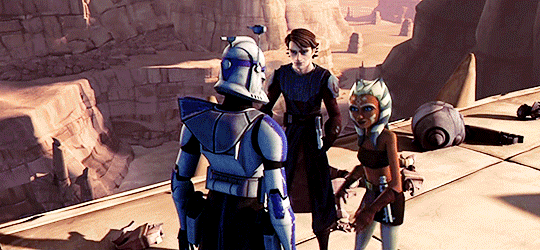
Gif from this post by @elivanto
Is this the first instance that we see of Yeet the Clone? I’m pretty sure it is. If so, then what a beautiful introduction to one of the Jedi’s favourite pastimes: Yeeting their Clones. Poor Rex. I also loved the part before this where he just appears behind the Droideka that Ahsoka was fighting on the top of the wall, smoothly and silently steps through its shield and then puts a blaster bolt through the back of its head a la Trinity to Agent Smith in The Matrix. Certified Rex Is A Badass moment and it was a really well shot and framed moment that emphasised just how highly skilled the clones are. I did wonder how he got up to the top of the giant wall that quickly though. Rex, did you yeet yourself up there? Do you secretly want to be yeeted?
I hadn’t really clocked onto this until this episode but it’s reminder that Rex is also an ARC, along with being the absolute BAMF that he is and The Captain to everyone. I was watching episodes 2x6 and 2x7 (more to come on those later) and was wondering why Cody didn’t have a kama. Surely Marshal Commander Cody has a kama? Is Cody not an ARC? Wookieepedia doesn’t list him as one so I’m guessing he mustn’t be, which seems decidedly odd seeing as he, along with Rex, are basically held up as examples of the ultimate clone. Though The Bad Batch aren’t ARCs but then they are a special category of genetically enhanced commandos in a spec ops squad of their own. Does this mean kama’s are purely an ARC thing? Either way, Rex looks suitably badass in his kama and Cody should get one too, as a treat. More clones in kamas pls.
Just after poor Rex gets yeeted off the wall by both of his jedis’, we very clearly see that Jedi are able to safely slow and stop the descent of a clone who is falling from a great height. They can even do this while falling from a great height themselves. So where is The Bad Batch’s jedi to stop Tech’s fall? Hmmmmmm?! I have Thoughts about this that I may cobble together into a post at a later date.
Hello to Trapper, who we’re introduced to as the only other survivor along with Obi-Wan from when their troop transport (I think they’re LAAT/i’s?) was shot down and crashed. I’m always slightly worried when we’re introduced to a new named clone. I thought Wooley was absolute Red Shirt material (to mix metaphors with the two main sci-fi franchises that start with Star) when he was introduced in 1x20 ‘Innocents of Ryloth’. The setup did not seem like it bode well for his survival. Four clones go off on their own on a dangerous mission to scout ahead. Wooley, the only clone out of the group without paint on their armour, is paired up with Cody (who has plot armour) and the other two clones, Waxer and Boil, have both been introduced and characterised at the start of this episode. Wooley was set up to be the obvious Red Shirt of the group, doomed to be blasted by the first droid they encounter while the main characters are left to struggle on in a desperate bid to complete their mission. Don’t get me wrong, I was very glad it didn’t happen! Subverting expectations like that worked well in this situation and the entire narrative focus was on Waxer and Boil anyway. More clones need to live.
That was one thing that stood out to me in this episode, the sheer number of clones that were killed right in front of us. There were so many. It was a constant pattern throughout the episode. Clone after clone after clone dying, and for what? I’m assuming this is the writers making a point about the futility of war and the utterly pointless loss of life. On top of all this, the clones are just expected to keep going, always moving forward, nothing else mattering apart from following orders (*sobs*) and completing the mission. It was a very sobering way of emphasising the lot of the clones and the way they’re treated and viewed. Just the sheer number of LAAT/i’s alone that were shot down was so stark, and each of those carries 35 troops. Or at least that’s what Wookieepedia says. I didn’t think they looked large enough to carry that many troops in the episode, probably closer to around 10 or so clones.
On a lighter note, I really enjoyed how a number of the LAAT/i’s had custom nose art! There was one with what looked like a nexu that I think appeared twice and another with a very cool looking clone trooper helmet that drawn to look like a skull. I love little in-universe touches like that. Ok I’ve done a little bit more digging and omg the LAAT/i with the nexu nose art is called the Bad Kitty! I am crying, this is hilarious, I love it.
Also, Cody can you come and get your husband. He’s all dusty and dirty and slumped against some boxes in the middle of a battlefield pretending not to be injured. Somewhere in the background is the decidedly miffed countenance of the 212th’s medic. Do we ever discover who the medic of the 212th is? Does Ghost Company have a medic? The only medic I know of is Kix and he hasn’t been introduced yet, plus he’s with the 501st anyway.
This is all further confirmation that I am entirely here for the clones. Sure the jedi with their fancy laser swords are cool and all that and I will admit that I’m growing rather fond of Ahsoka. But the clones. The Clones. Give me everything about the clones.
#star wars#sw#the clone wars#clone wars#tcw#sw the clone wars#sw clone wars#sw tcw#watching the clone wars for the first time#rex#captain rex#yeet the clone#clone troopers#obi wan kenobi#obiwan kenobi#kenobi#ahsoka#ahsoka tano#reaction#thoughts
9 notes
·
View notes
Text
Powerful Villains
I believe most people on this beautiful planet are good. We go about our daily lives while trying to do the right thing, help people, and take the blame for our actions. Yet, a few people are less than ideal, and an even smaller number are truly evil. Some examples would be The WWII Axis leaders Ivan the Terrible, Saddam Hussain, the North Korean Kim dynasty, serial killer Jeffery Dahmer, and cult leader David Koresh.
How do the bad people feel about their actions? Let’s examine an aggressive driver that constantly places others in danger. There would be incidents, and their mind would develop a defense mechanism. “The rest of my life is great; this is my one escape.” Complete denial, “Everybody drives bad. I’m no exception.” A deflection, “I’m a skilled driver. Nobody else can drive.” A defensive argument, “I’m protecting myself from other drivers.” Or a deferral, “The rest of my life is great, and this is my one escape.”
Fictional villains are in a different class because their purpose is to entertain. Several examples come to mind: the crazy book fan in Stephen King novel Misery, Darth Vader from Star Wars, Joker from Batman, Hans Gruber from Die Hard, and Agent Smith from The Matrix.
Writers add villains to give the moral character a reason to fight, add tension, advance the plot, or make the excellent character look even better. These characters span the range from slightly annoying to beyond contempt. Selfish motives, anger, aggression, laziness, a love of inflicting pain and a lack of empathy define them.
There is a big difference between a fictional villain and a real-life person. They must have a clearly defined motivation. Readers need to know why a person is the way they are, or they will be confused. The backstory can be a simple “he had an awful childhood” or an entire chapter dedicated to their history with the other characters.
In my first book, Interviewing Immortality. My villain appears as a dominatrix serial killer. Later, I reveal that she is not truly evil (at least in her mind). Her level of violence is far above average, and her attitude contains a thin sliver of compassion. By the end of the book, the reader is not fully convinced that she is a good person, but they clearly understand her motives.
What about crazy people? My advice is to use the characters sparingly. For example, in my fifth book, Kim and Gabe Thrive (now in the writing phase), my main character is pumping gas when a random jerk insults her. She insults the person back and drives away with no further interaction.
In this brief encounter, I used this villain to show the main character is strong, specifically as a mother who does not accept insults, which would be an excellent example to her daughter. It would be necessary to provide a full background if there was a need for further interaction.
What about a supernatural story where characters are mean all the time? Say a dystopian reality. The author would have to lay a different foundation for this type of story. In crazy world, everybody is a jerk.
What about a supervillain like the type that James Bond would encounter? There must be logic behind the villain’s actions (usually money). In this extreme case, the reader does not necessarily relate to the villain, but they respect their logic, even if it is vastly flawed. In my humble writings, I try to stay from super/extreme characters because I have never interacted with such people, which makes it difficult to imagine such a character.
What about a real-life supervillain, Saddam Hussain, or Jeffery Dahmer. Reality can be muddy, and readers need clarity. James Bond would go after the supervillain in a fictional story, but the media would have over-the-top coverage until the world’s armies stopped Saddam Hussain or Jeffery Dahmer.
Some villains do not fit the traditional mold, like the anti-hero. Or the super nice person who makes us feel terrible. Characters like this are in their class, and their motivations are complex. In such a chase, it is essential to have an entire backstory, or the reader will put down the book.
Where does this all lead us? A good villain must have a clear foundation, a rational motive, and be relatable. The writer needs an obvious goal for the villain to move the plot along. By the end of the story, the reader should have fully understood their motives, which will allow them to tolerate their awful actions.
What about me? Am I a villain? I try hard to live a good life, treat people respectfully, and help where possible. However, I have room to grow and know of several colossal failures. If I were to be honest with myself, I am a B+.
Wait a minute. I write books that contain stories about bad people. They torture, kill, and are not productive members of society. Does that mean I am in denial of my true self? Denial is the most significant trait of a villain. Hmm. Something to think about.
You’re the best -Bill
August 27, 2023
Hey book lovers, I published four. Please check them out:
Interviewing Immortality. A dramatic first-person psychological thriller that weaves a tale of intrigue, suspense, and self-confrontation.
Pushed to the Edge of Survival. A drama, romance, and science fiction story about two unlikely people surviving a shipwreck and living with the consequences.
Cable Ties. A slow-burn political thriller that reflects the realities of modern intelligence, law enforcement, department cooperation, and international politics.
Saving Immortality. Continuing in the first-person psychological thriller genre, James Kimble searches for his former captor to answer his life’s questions.
These books are available in soft-cover on Amazon and eBook format everywhere.
0 notes
Text
Onwards we go!
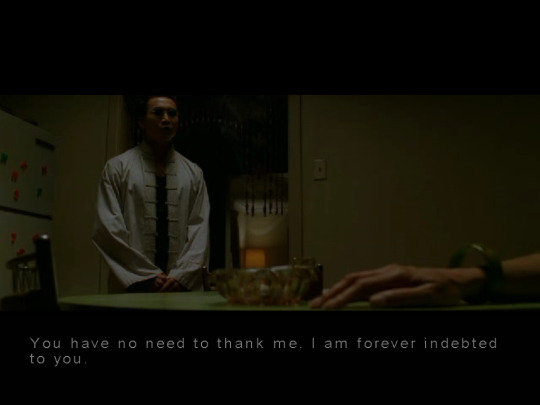
I often wonder what the Oracle did for Seraph to inspire this kind of loyalty. Despite the fact that the Oracle is played by Mary Alice, I feel like this takes place before her meeting with Neo in Reloaded, and they just get the chance to shoot this scene with Gloria Foster before she passed away. Also, considering that Seraph has only come back to her now, maybe this means that Rama Kandra has already been to see her and she's just getting some extra protection in case the Merovingian tries anything funny.


I love the choreography of this fight sign, Seraph's kung fu against Ballard's more boxing style. (Which makes sense given that Ballard's actor, Roy Jones Jr, is a very well known boxer).
The next scene is more talk between the Oracle and Seraph, regarding the unfolding events of the sequel films, including a cutaway to Bane being assimilated by Smith (Alas, poor Bane, how little we knew you!). The Oracle makes note of there being so many factors at play, so many choices, and so much fear. And we cut to one example of all three:
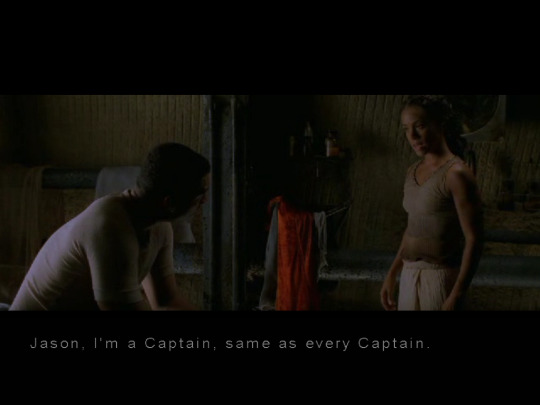

Jason proceeds to tell Niobe about his plan, and why she's not going. He initially states it's because the ship's EMP is too weak to be effective (which may very well be the case), but privately it's because he doesn't want her in harms way because he loves her. Just like Neo and Trinity.
Neo also asked Trinity to stay out of the Matrix, even if he didn't elaborate too much on the reason. Trinity at least listened to Neo without too much complaint, and only went into the Matrix when it became clear that she needed to be in there to help Neo get to the source.
Jason, on the other hand, made the call to protect Niobe without her permission, or even asking her thoughts on it, which understandably Niobe is pissed about. And then she went on to defy him by volunteering to find the Neb.
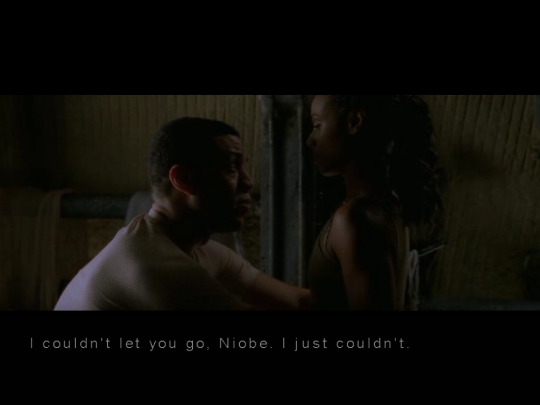
Another parallel with Neo/Trinity. Except while Jason does love Niobe, it's not a healthy relationship, and it's failing. It's tragic, really.

Which is true, if it hadn't been for all the supporting characters helping Neo along the way, Trinity especially, Neo would not have gotten as far as he did.
And as the Oracle states: If one fails, all fail. (Sorta).

And here we have the team post-meeting. Ghost looks just as done with everything as Sparks is. They're still going to follow her, to hell if necessary, but man they wish she would stop going!
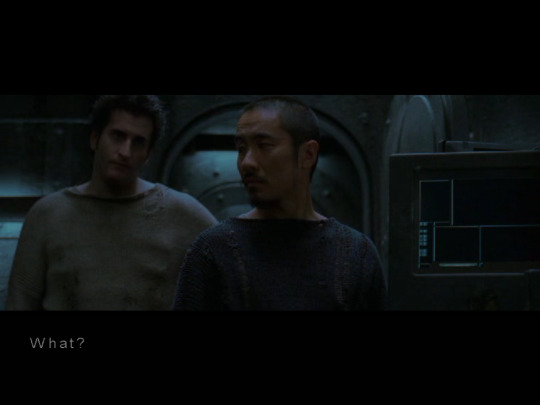

I love that Ghost looks to Sparks first, almost anticipating that he's going to say something, but he doesn't get the chance to make a smart remark. But the arm fold says it all.

Famous last words! And now, onto the last driving section of the game, and the one that is actually playable.
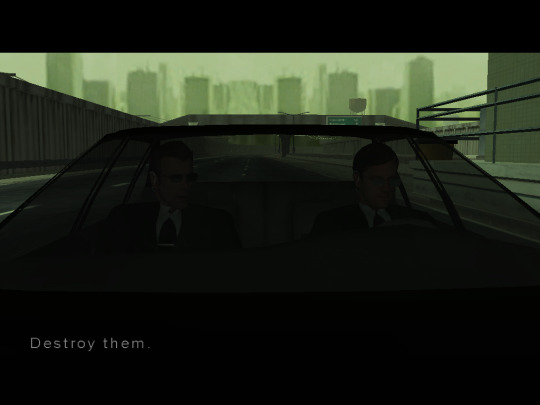
Dun dun dun, here come the agents. Jackson (I think), and Thompson? Although the Agents in the chase scene in the film are Johnson and Thompson, so looks like I mixed up the Agents. Whoops!
Eventually, they give up chasing Niobe and Ghost, and return back to chasing the Keymaker.
Speaking of exiles:

See that fire on the bridge ahead? Yeah, now that's good continuity!
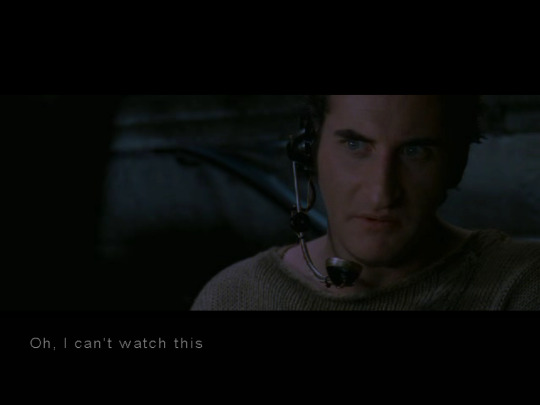
That bad, huh? Because of course the middle of a highway chase is the perfect time to ask someone for their stuff!!

And hey, it's Morpheus! And yes, you can see them properly fighting the whole time you're chasing them! Again, the continuity of this level is spot on!
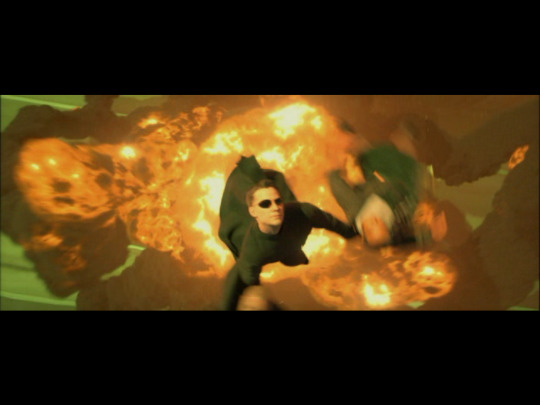
And of course, we rescue Morpheus, and the Neo rescues him and the Keymaker yada yada. There was supposed to be a scene after this where Niobe and Ghost get cornered by a bunch of agents, and Neo saves them, but it was dummied out. Bummer!

Once again, Ghost is thinking he does not get paid enough for this. Also, either Ghost is still plugged in, or Sparks put that headjack away reeeeeally quickly! Or it's just hanging behind the chair because Sparks needed to get this off his chest NOW. Which means Ghost woke up and immediately had an irate Sparks in his face.
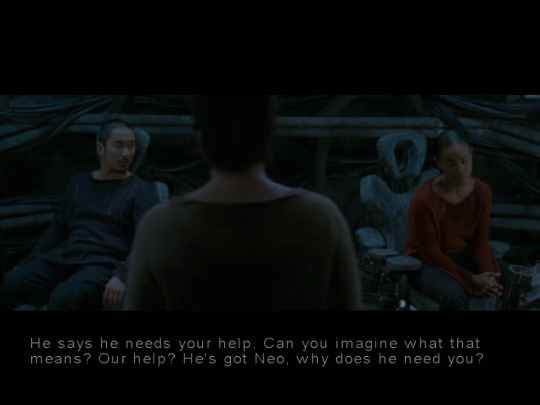
I mean, from his perspective he had a valid point. Neo can do anything, why does Morpheus need Niobe and Ghost so badly? It doesn't look great. Although how much of this is genuine concern or him just wanting to get the hell out of there and save his own skin is up for debate.

Don't worry buddy, I'm listening, you go right ahead :)

Maybe not the smartest thing to say to your colleagues/friends here. I don't know whether he was trying to lighten the mood here in a weird sort of way, or trying to guilt trip them. Either way, it didn't work.


Or just trying to provoke a response from them in general? Sparks has always been described as a coward who would do anything to save his own skin, so this is no surprise. I do think there is more to him though, he does care, it's just the cowardly aspects come to the forefront first and foremost.
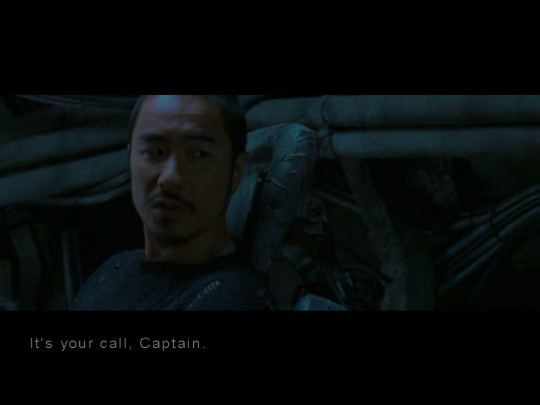
I get the feeling that Ghost already knows they're going in to help, he's trying to make it easier for Niobe to not feel bad about dragging them back into the field.
Okay, that's it for today! Might need to take a break, as I still need to play the next level (which is one of the my favourite levels in the game), but will try and update tomorrow night as well! See you then!
Guess who's doing rewatches again? It's me, and well, not entirely a rewatch:

Yes, that's right, it's Enter the Matrix. Because it's criminal that for a blog named for the little ship that could, I've haven't actually done a deep dive on the game itself! So I'm going to fix that!
I'm also going to play through as both Niobe and Ghost, as depending on who you're playing, the missions play out slightly different, and the cutscene dialogue varies as well. Also, not going to do like a blow by blow kinda thing. Only going to comment on things that caught my interest, or seem rather amusing to me. If you want a little more context, I suggest checking out the couple of playthroughs/cut scene compilations on youtube.
Also of note, the game picks up right after the Animatrix short Final Flight of the Osiris.
Anyway, let's get to it!

AND IT'S THE MAIN REASON I'M STILL HERE, BECAUSE OF THIS PESSIMISTIC SNARKY COWARD RIGHT HERE. And he's self aware about it as well.
Also interesting to note is that according to this cutscene, Sparks has been operating on board the Logos for 3 years. Now, a standard US navy tour of duty (and I'm going with Navy rather than Army as Zion's army is referred to as a Navy fleet) is between 2-3 years. Not really going anywhere with this, but it's interesting to note.

Niobe is a 'my way or the highway' kinda person. No wonder it didn't work between her and Morpheus. It's also telling that Ghost has known Niobe for long enough to know that this is what she's like. I wonder if Ghost is the glue in this ship dynamic? As in, he knew Niobe and Sparks separately before they knew each other, if that makes sense?

And it's the little hovership that could, the little lightning bug of the fleet! Those red lights on the ship look like they're the same as the ones on the sentinels. I wonder if a bulb blows or something they scavenge one from a deactivated squiddie as a replacement?

It's not particularly clear, but I never realised that Niobe's hair is tied with what looks like string with gold in it? Maybe a metal band with gold on it? I'm not sure, but it's pretty!
Also, I appreciate that they give a reason why Niobe is going after this drop, rather than waiting for someone else (ie: Neo) to go get it.
Also, saying are you red or blue on this is a very cool in universe way of saying are you with me or not?
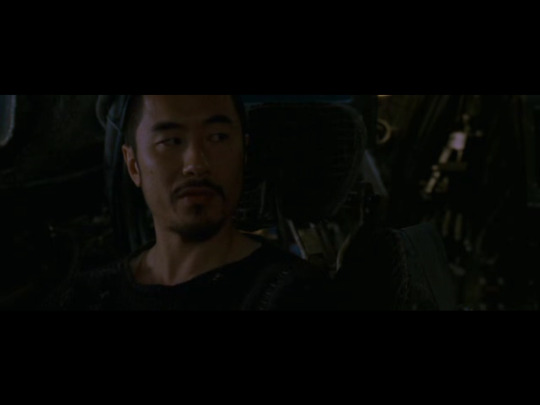
The subtitles are missing here, but what he says:
"You know me Niobe. It's not a choice, it's a way of life."
Ghost, you're awesome, you know that, right?
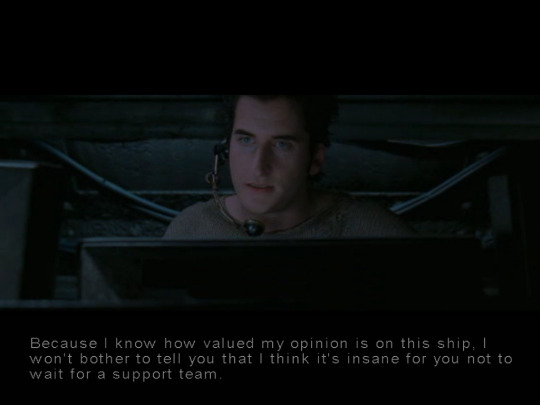
I get Sparks' complaint here, there are only two of them, and it would be a lot safer to wait for back up to help them out. But nope, you know what Niobe's like, get it done.
Also, as I remarked earlier, the fact that Niobe is willing to risk going in without support , especially given what she says about Thaddeus not using the drops unless he had no choice? And now they're all dead? They definitely need to get that package before the agents do.

I personally love Niobe's little eye roll here.
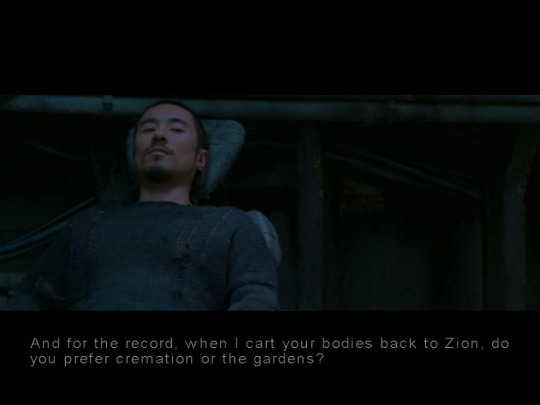
I also love that Ghost is more chill and amused by Sparks than exasperated like Niobe is. Yeah, Ghost is the glue holding the team together.
Also, a little mention of Zion funerary practices. As someone pointed out to me years ago, I suspect that the gardens is similar to the Exodus fleet's method of burial, but who knows?
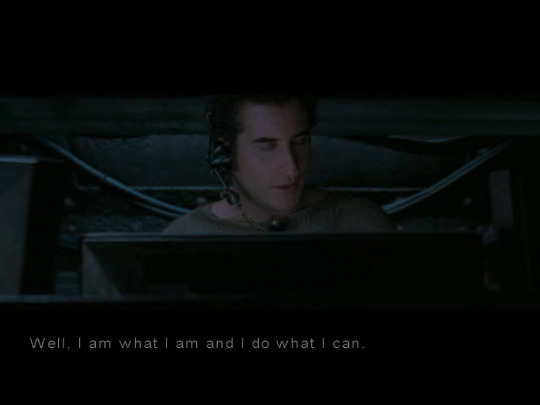
Yup, words to live by!

Once again, Niobe is rolling her eyes behind the sunnies. This is what she has to put up with. Also, I would love to think that one time Sparks pranked Ghost by running some program that sent his guns soaring upward.
I always used to think that Ghost was the serious, no nonsense one in the crew, but I'm beginning to think I'm wrong on that front.

Sparks, why do you want his boots? They're too small for your big feet!

Niobe has great taste in old muscle cars. Good old 1967 Pontiac Firebird, in eggplant purple instead of black. Very stylish!
That's all for now, next up will be the post office. See you then!
32 notes
·
View notes
Text
More random thoughts and a wild theory.
So I’ve been thinking... buckle up because this is going to get long and potentially confusing.
There is one thing about the first movie that unless you have shipping goggles on (which I’ve always had even when “shipping” wasn’t a thing), or your suspension of disbelief is strong, or you’ve played Matrix Online and put 2 and 2 together (okay maybe not 2 and 2, more like √84,2*10^75), doesn’t quite sit right and is never explained properly in the trilogy.
The fact that Neo “unlocks” his powers, comes back to life and becomes “The One” after Trinity kisses him.

He becomes The One, stops bullets… then, for reasons, he jumps into Smith, they become positive and negative… and Reloaded and Revolutions happen.
He was already The One before jumping into Smith.
Their connection, the positive/negative, the balancing of the equation, the reason why Neo has something to bargain for peace at the end of Revolutions, all feels like a side story to me. A very big side story, but still.
It’s as if at the end of the 6th book, Harry Potter sets out to destroy the Horcruxes… and in the 7th he finds a way to blackmail Voldemort into behaving without destroying the Horcruxes. Great example there… but I hope it explains my point.
The important bit there is that Trinity kisses him. That’s what makes him The One. With everything happening in Reloaded and Revolutions we all kinda sorta forgot about it.

Of course, their connection remains fundamental...
...it's actually the reason why Neo makes a different choice from his predecessors at the end of Reloaded and kickstarts the chain of events that will bring temporary (keyword there) peace between men and machines… but a chunk of story is still missing, and that brings us to... Resurrections.
- So, Neo becomes the one because Trinity kisses him. -
What does that mean?
*what follows is my idea, my opinion and at the time I’m writing this I have nothing to back it up with, except some bits and pieces*
If you ask me, it means that they are both bearers of two pieces of ultimate code that when it comes into contact (if we can consider a kiss as contact, and considering Sense8 and how Lana works, I’d say HELL YEAH!) creates The One.
This means that if the situation was reversed, and Trinity was the one plugged in and Neo kissed her, she would have become The One instead of him, because all that needed to happen was for their codes to merge... that's why they are BOTH as strong and fast as agents in this trailer.
In Matrix Online, Trinity and Neo’s golden codes had to do with creating a single code that would mimic human DNA (I think, sadly I never got to play it so I’m basing this on stuff I read) eliminating the barriers between man and machine. It was a project the machines had been working on to free themselves of their robotic bodies basically. If you’ve played Mass Effect I think you could summarize this with “Synthesis”.
Now, I don’t know if Lana went with this storyline that was already paved, but I’ve a gut feeling that she didn’t, that she went for a much more deep reason why their connection is so important. I mean, over the years the word “connection” has become the center of her work as a director and storyteller, so for these characters that are “arguably the two most important characters in my life” her words not mine, I think she went all out.
That’s why in the trailer they do this:

And this happens:

That’s why Neil Patrick Harris, the new Architect, keeps shoving blue pills down Neo’s throat, thats why he’s doing everything in his power to keep them away from each other, and that’s why when they come into contact all hell breaks loose.
Thank you for coming to my TED talk.
#the matrix#the matrix trilogy#the matrix resurrections#the matrix: resurrections#neo x trinity#trinity x neo#keanu reeves#carrie anne moss#long post
151 notes
·
View notes
Text
modern gothic, sci-fi, and the moral binary: why the matrix is one of the most relevant gothic pieces of the last twenty five years
the gothic is a genre that is designed to explore transgressive behaviours and private desires, and often does so by having these explicit acts committed by a supernatural character. this serves to not only characterise the behaviour as monstrous but ‘Other’ people who behave that way. while this is typical of traditional gothic literature, modern gothic tends to present sympathetic villains, who suggest to audiences that transgressive behaviours are not inherently threatening or deserving of punishment, but simply different. as put by kelley hurley, ‘through depicting the abhuman, the gothic reaffirms and reconstructs human identity.’ in order to understand the progression from traditional gothic to modern genres that stem from it, namely science fiction, psychological thrillers and murder mysteries, we must first understand it’s basic timeline.
gothic literature began as a genre with very little positive reception, originally seen as a frivolous, and unserious style of writing. often called ‘dark romanticism’, the genre used the ‘purple prose’ and decadent architecture of romantic literature, but associated it with more sinister narratives concerning religion, murder and both sexual and identitiy-oriented transgression. originating from horace walpole’s ‘castle of otranto’, the genre was used to reflect the cultural anxieties of the time period, and thus gained traction by being temporally relevant. modern gothic’s deconstruction of the ‘good vs evil’ binary is a reflection of contemporary understandings of the aforementioned topics, which address the complexities of transgression. notable examples of later gothic literature include susan hill’s 1983 novel, ‘the woman in black’, a pastiche of traditional victorian ghost stories that utilises sympathetic villains to add complexity to the idea of villainy. additionally, the work of angela carter, particularly that of her 1979 collection ‘the bloody chamber’ which uses gothic conventions to subvert more conservative fairytales and fables, another instance of this ‘dark romanticism’ technique.
by presenting transgression as complex, rather than fulfilling one side of a binary, modern gothic allows us to consider if transgression is even that dangerous; it serves to dismantle the idea that ‘different = threatening.’ a brilliant example of this is the previously mentioned work of carter, and her short stories ‘the tiger’s bride’ and ‘the courtship of mr lyon.’ these stories are subverted retellings of the traditional ‘beauty and the beast’ fairytale. While maintaining the general events of the original ending, where beauty stays with the beast of her own volition, carter offers up two dynamics between the human and abhuman that serve to recharacterise ‘Othered’ creatures as less threatening and more sympathetic and innocent. ‘the courtship of mr lyon’ mimics the original story’s ending, with beauty’s understanding of the beast resulting in his transformation back to human. ‘the tiger’s bride’ offers the reverse: in beauty’s acceptance of the beast, she transforms to be animal-like like him as well. this appears almost as an act of solidarity. perhaps an incredibly modern reading of carter’s metamorphosed characters is as an allegory for transgenderism. discussions around gender identity during the 1970s in britain, even in second-wave feminist circles, were more concerned with rejecting and redefining traditional gender roles than they were with the personal identity of individuals, so we can assume this was not carter’s intention when writing these stories. however, ideas of physical transformation, and how proximity to the ‘Other’ can ‘radicalise’ one’s own identity are very fitting with treatment of transgender people both historically and presently. genres that stem from the late gothic, namely sci-fi, have been known for using metamorphosis as an allegory for marginalised identities, using physical transformation as an allegory for ideological or emotional transformation. a prime example of this is lana and lilly wachowski’s series ‘the matrix.’ written as a trans allegory, the movie series criticises the social pressure for conformity the way carter does and attempts to explicitly recharacterise trans people as an innocent non-conforming identity rather than a threat. carter’s exploration and reproval of established values similarly tends to centre around ideas of gender, making this reading not entirely unreasonable. she suggests that societal fears surrounding gender identity and liberation are unfounded.
ultimately, carter paints various traits and identities that are widely considered ‘threatening’ to be multifaceted and liberating instead, as she views the established values that they ‘threaten’ to be restrictive and in need of changing. the matrix represents these established values with ‘agents’ who attempt to hide the true nature of the world from the population. in the preface to the bloody chamber collection, helen simpson writes that 'human nature is not immutable, human beings are capable of change', arguing this point as the core of carter’s gothic subversions. she suggests through her writing that what is perceived as a social threat is often based upon what is uncomfortable rather than what is actually dangerous. her work is partially ambivalent in that it does not instruct what is right or wrong, but instead depicts societal relationships and allows the audience to interpret it.
the matrix achieves a similar result, with gothic elements and subversions supporting it’s messages.sci-fi takes gothic settings, ideas of liminality, decay, transgression and the Other, and recontextualises them with in the hypothetical far future. traditional gothic settings such as the ruins of decadent mansions become abandoned high-tech buildings. the binary between conventional and transgressive shifts from being a contrast between catholic ideals and more modern behaviours to being a contrast between those profiting off capitalism and those suffering from it.
implicit in the matrix’s notion of discovering a newer world more true to reality is the idea that ‘different’ or ‘unconventional’ experiences and identities are not threatening, but liberating. the matrix suggests we can unlearn our villainisation of trans people, and does so through the use of various gothic conventions. to begin with, gothic texts are often written to reflect the cultural anxieties of the moment. lilly wachowski has stated that the movie was ‘born out of anger at capitalism and the corporate structure and forms of oppression.’ the late nineties in america was certainly a time of tension for lgbt people. frank rich sites ‘the homophobic epidemic of '98...spiked with the october murder of matthew shepard’ as an era of extreme difficulty for the lgbt community in the usa. this hostile environment is reflected in the nature of the matrix’s ‘agents’ and their insistence on maintaining the illusion of free will that comes with the false reality they push. they are in no way open to ideas that differ from their own and actively come down on those who suggest them. this anxiety for the lgbt community is reflected in the movie; the anxiety itself is expressed through a combination of subverted and traditional gothic tropes. gender itself is a topic highly relevant to the gothic. the wachowskis utilise binary oppositions, the most obvious example being the red pill vs blue pill’ scenario. the movie poses a stark contrast between two approaches to life: ‘the willingness to learn a potentially unsettling or life-changing truth, by taking the red pill, or remaining in contented ignorance with the blue pill.’ its interesting for a piece that is intentioned to deconstruct binaries to construct this binary, but it does serve a purpose. this binary serves as a device to show, allegorically, the experience of trans people in western cultures. belinda mcclory’s character, switch, is a specific representation of the gender transition process. in the matrix she appears as a woman, and in the real world as a man. while the wachowskis may not have had the creative freedom to include an explicitly transgender character, this was the closest and most specific hint they could have given the audience, right down to the character’s cratylic naming. switch’s experience presenting as both man and woman, and only one of her presentations occurs in the ‘true reality’ that is representative of people’s true natures and personalities. this use of metamorphosis mimics the way many trans people must present as their assigned gender at birth in public, and their true identity in private, that their physical body and their perception of themselves when they have control of their appearance are not necessarily aligned. this parallel relies upon the binary consisting of a false reality and a true one to illustrate its point.
it has also been suggested that the red pill is representative of a hormone pill, and many viewers have likened neo’s mental restlessness to gender dysphoria: ‘what you know you can't explain, but you feel it. you've felt it your entire life, that there's something wrong with the world. you don't know what it is, but it's there, like a splinter in your mind, driving you mad.’ these small parallels coalesce to form the movie’s representation of the trans experience in a way that is arguaby subtle to the cisgender viewer. neo openly rejects being called ‘mr anderson’ or ‘thomas anderson’ from our first introduction to him. he replaces his given male-coded name with something seemingly androgenous for his own comfort, and ‘mr anderson’ almost serves as a deadname, which only the agents who enforce a false reality use to refer to him. agent smith uses neo’s two names to frame his two separate lives very distinctly; ‘one of these lives has a future, and one of them does not.’ with an understanding of the trans subtext of the movie, this appears as a thinly veiled reference to the difficulties openly trans people face. coming out, in most places in the world, can result in loss of employment, loss of contact with family, and so on. as put by lili wachowski, ‘transgender people without support, means and privilege do not have this luxury. and many do not survive.’ agent smith appears to be warning neo of the dangerous of living as his true self, insistently referring to him with his given name rather than his chosen one, even if just for bureaucratic reasons. neo’s name is a vital to his defiance against both agent smith and the false reality he seeks to maintain:
agent smith:
you hear that mr. anderson?... that is the sound of inevitability... it is the sound of your death... goodbye, mr. anderson...
neo:
my name... is neo.
in defiantly maintaining his chosen name, neo pushes for the true reality to be accepted and understood. this is motivated by the fact that ‘i don't like the idea that I'm not in control of my life.’ this is an instance of neo taking control, by asserting his identity. the high stakes of this scene mimic the high stakes that trans people face in asserting their identities in an unaccepting social climate. the movie also acknowledges the public perception of trans people as a threat: ‘i know that you're afraid... you're afraid of us. you're afraid of change...the matrix is a system, neo, that system is our enemy.’ appearance vs reality is yet another key aspect of the gothic that is utilised in the matrix, and the narrative forces the viewer to consider whether they would accept a harsh reality or prefer total ignorance and accept what appears in front of them.
the movie’s treatment of violence against its protagonist is particularly relevant to the gothic. typically, queer-coded men or people of colour in fiction experience physical violence allegorical to the way female characters are written into sexualised danger: for trauma-based character development. violence against minorities in media, specifically gothic media, is often symbolic rather than just plain horrific. female, queer or bodies of colour are seen solely as political identities, so the violence they face is violence against an idea, not a person. queer or queer-coded men like neo are often feminised to a certain extent, even if its simply rejecting the title ‘mr’, to allow the violence against them to be symbolic or political rather than personal. often with cisgender, heterosexual, white or male characters, any cruelty they face is considered to be senseless and is characterised as brutal, pure violence, as their bodies are simply allowed to exist as bodies without a political statement attached to their existence. they are not making a statement or defying standards simply by having bodies. the gothic specifically uses symbolic violence in its later stages, and it is often faced by characters who are ‘Othered’ such as frankenstein’s monster being faced with angry hordes of people, or the suicide of jennet humfrye, the titular character of the woman in black who had a child out of wedlock. this symbolic violence in the matrix is particularly relevant to the above scene between agent smith and neo, where neo’s retaliation involves not just physical fighting but defiance over his own identity.
setting in the matrix is quintessentially modern gothic, and is an integral part of characterising the differences between appearance and reality. the real world and the matrix are characterised both by their physical appearance and the characters associated with them. the whole movie is shot with relatively bleak green, grey and blue tones; the unnamed cities in the matrix were filmed in sydney, australia, but are supposed to appear as a city that could be located anywhere. this makes viewers somewhat comforted as the cities appear familiar, but their association with the antagonistic agents makes it difficult to truly identify with them. in contrast, the real world appears cold, crude and difficult to survive in, but is home to a crew of sympathetic rebels that the audience is supposed to root for. the city of zion is all harsh metal and can feel like a very temporary, unsafe residence but scenes such as the party in matrix reloaded characterise it as a place of community. the duality of each setting is typical of the gothic, and allows the viewer to explore the complexity of the movie’s conundrum. no option is the easy, immediate or obvious choice. the viewer must consult their own morals and values. ideas and anxieties surrounding moral decay are vital to the narrative of gothic tales; the genre explores and seeks to define humanity, and doing so often involves ethnocentric set of morals associated with good and bad. concepts like metamorphosis, identity, and the rejection of religion or christian/western ideals all play into this, but this is where modern gothic’s acknowledgement of complexity reframes things. most developments described as ‘modern gothic’ apply to sci-fi as it is an extension of, or evolved from,1960s-1990s gothic.
in presenting the aforementioned topics as multifaceted, the genre is able to imply or sometimes directly suggest that the ways in which presentations of them differ from established values is not immediately threatening, but simply different or even sympathetic. the matrix almost reverses traditional expressions of transgression by suggesting that those seeking to maintain the status quo are enforcing restrictive and immoral ideals, and that those whose agendas differ from the status quo are seeking liberation. this appears very similarly in angela carter’s previously mentioned work, exemplifying the parallels between sci-fi and the gothic. ‘the matrix stuff was all about the desire for transformation but it was all coming from a closeted point of view.’ lilly wachowski states. transformation and metamorphosis are topics so in line with the content of the gothic, allowing authors to explore and compare different states of being in order to eventually, sometimes implicitly, condemn one and promote the other. in reference to how she was drawn to use sci-fi as the medium for this story, she says that ‘we were existing in a space where the words didn't exist, so we were always living in a world of imagination.’ things that cannot work in our social climate can be allowed to work in an imagined scenario, with imagined consequences separate from the real world, similarly to the gothic’s use of the supernatural as a vehicle for taboo actions and values.
the wachowskis select science fiction tropes that are core to the gothic as a medium for the matrix’s allegorical meaning: taboo subjects, metamorphosis, binary oppositions, moral questions and stark settings. the matrix arguably serves as a bridge between the two genres, while also being unmistakably modern in its support of trans people and its open criticism of capitalism and social systems. this is not to say that earlier texts do not argue similarly points, but that the popularity of the matrix means that these points and messages are widespread and consumed by a massive audience. the movie was released in early june of 1999, and by august 2000, the matrix dvd had sold over three million copies in usa, making it the best-selling of all time. its unlikely that those three million dvd owners had all interpreted the movie the way the wachowskis had intended, as is the case with all media, but their anti-capitalist and pro-lgbt rhetoric was still present in the movie and has become glaringly obvious to more viewers over 20 years beyond its release date. using binaries as a tool to deconstruct other binaries is a device used more and more within sci-fi and the exploration of morals, systemic structures and the role of lgbt people are both vital to both genres. trans people are originally characterised as ‘Other’, but are rightfully humanised and encouraged to pursue their true identities: ‘to deny our impulses is to deny the very thing that makes us human.’
i.k.b
#mine#essay#literature essay#film essay#film analysis#matrix#the matrix 1999#lilly wachowski#lana wachowski#the wachowskis#gothic literature#scifi#science fiction#analysis#analytical essay#copyright ikb#the matrix analysis#the matrix trilogy#keanu reeves#neo#trans allegory#matrix trans allegory#lgbtq cinema#lgbt#angela carter#the bloody chamber#modern gothic#anti capitalism#trans movies
81 notes
·
View notes
Text
Daniel LaRusso: A Queer Feminine Fairytale Analysis Part 1 of 3
Disclaimers and trigger warnings:
1. These fairytales are European, although there’s often overlap in themes globally. I know European fairytales better, which is essentially the reason I’m not going to branch out too far. I opted to also stick to Western movies so as not to narrow things down, but also in particular “waves hand towards all of Ghibli” amongst many others. There’s a reason the guys in Ghibli are so gender.
2. TW for discussions of rape culture and rape fantasies
EDIT: FUCK I’M A GOBLIN CHILD! FORGOT TO PUT A MASSIVE MASSIVE THANK YOU TO @mimsyaf WHO HAS BEEN THE NICEST, KINDEST EDITOR ON THESE THOUGHTS AND CONTRIBUTED SO MUCH TO THEM AND GENERALLY IS A WONDERFUL PERSON!
Part 2
Part 3
1. Introduction
I recently wrote a little thing, which was about Daniel as a fairytale protagonist – specifically one that goes through some of the kinds of transformations that are often associated with female protagonists of fairytales.
I used quotes from Red Riding Hood, Labyrinth, Buffy The Vampire Slayer, and Dracula, which, as an aside – the overlap between fairytales, horror, and fantasy and the ways each of those genres delve into very deep, basic questions of humanity and the world is something that will always make me feral. I will be generally sticking with fairytales though. Also I am very excited about some of those Labyrinth concepts going around!
I’m going to use “feminine” and “masculine” in both gendered (as in relating specifically to people) and non-gendered (as in relating to codes) ways throughout this, depending on context.
To be binary for a moment, because sample-sizes of other genders are low, women are usually able to fall into either feminine or masculine arcs, although sometimes the masculine-coded woman can become a “not like the other girls” stereotype and the feminine-coded woman a shallow cliché – in both cases they’re also under more scrutiny and judgement, so it’s always worth asking “is this character not working for me because of the writing or because I have ingrained biases? (Both?)”
Men don’t often get feminine-coded arcs. Because. Probably a mix of biases and bigotry. But there are some that seem to have slipped beneath the shuttered fence of “Sufficient Narrative Testosterone,” and Daniel LaRusso is one of them.
2. Some Dude Comparisons (Men Doing Manly Action-Hero Things like being trans symbolism and loving your girlfriend… seriously those things are hella manly, I wish we saw more of that onscreen…)
a. Neo
Much like Neo The Matrix, whose journey is filled with transgender subtext and specifically and repeatedly references Alice In Wonderland, Daniel doesn’t go through quite the kind of hero's journey usually associated with Yer Standard Male Hero, especially the type found in the 80s/90s.
Neo is my favourite comparison, because of the purposefulness of his journey as a trans narrative and the use of Alice. But I’m sure there are other non-traditional male heroes out there (but are they trans tho? Please tell me, I want trans action heroes).
Neo “passes” as a socially acceptable man, but online goes by a different name - the name he prefers to be known by - feels like there’s something inherently wrong about the world around him and his body’s place in that society, and then gets taken down the rabbit hole (with his consent, although without really “knowing” what he’s consenting to) to discover that it’s the world that’s wrong - not him. And by accessing this truth he can literally make his body do and become whatever he wants it to.
Yay. (The message of the Matrix is actually that trans people can fly).
Neo is – kind of like Daniel – a strange character for Very Cis Straight Guys to imprint on. He spends most of the first movie unsure about what’s going on, out of his depth, and often getting beaten up. He is compared to Alice several times and at the end he dies. He loses. He has to be woken up with true love’s kiss, in a fun little Sleeping Beauty/Snow White twist. Yes, after that he can fly, but before that he’s getting dead-named and hate-crimed by The Most Obvious Stand-In For Normativity, Agent Smith, and being carried by people far more physically capable than he is (people who also fall outside of normative existence).
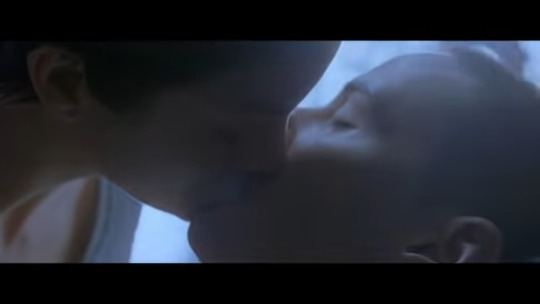
Trinity and Neo in The Matrix. The fact that a lot of the time neither of them is gendered is something. Literally brought to life by true love’s kiss.
I’m not about to argue that Daniel LaRusso is purposefully written along these same thought processes, so much as the luck of the way he was written, cast, directed, acted, and costumed all came together in the right way. And this is even more obvious when compared to That Other Underdog Fite Movie That Was By The Same Director as Karate Kid.
b. Rocky
The interesting thing about Rocky is that he is (despite being a male action icon) also not written as a Traditionally Masculine person. Large portions of Rocky – and subsequent Rocky films – are his fear and insecurity about fighting vs his inability to apply his skills to another piece of work and wanting to do right by his girlfriend (and future wife), Adrian. The fighting is most often pushed onto him against his will.
Much like in Karate Kid there is barely any fighting in Rocky I. Most of it is dedicated to how much Rocky loves Adrian and the two of them getting together. The fight is – again like in Karate Kid – a necessary violence, rather than a glorified one (within the plot, obviously watching any movie like this is also partly about the badassness of some element of the violence – whether stamina or the crane kick, it’s all about not backing down against a more powerful opponent).
Rocky is played by Sylvester Stallone. He’s tough, he’s already a fighter (albeit in the movie not a great one yet), he’s taking the fight for cash – so although he’s also soft-spoken and sweet, you’re aware of the fact that he’s got those traits that’d make a male audience go “Hell Yeah, A Man,” or whatever it is a male audience does watching movies like that… cis straight men imprinting on oiled muscle men sure is a strange phenomenon, why do you wanna watch a boxing match? So you can watch toned guys groaning and grappling with each other? Because you want to feel like A Man by allowing yourself to touch the skin of other men?
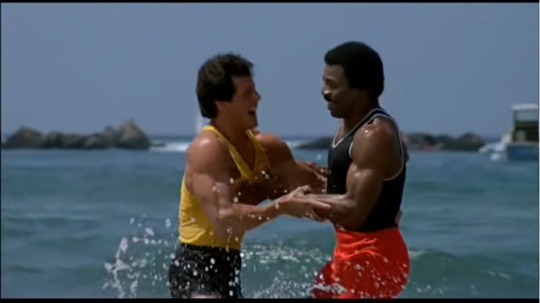
Apollo and Rocky in Rocky III. This sequence also includes prolonged shots of their crotches as they run. Sylvester Stallone directed this. This was intentional. Bros.
Daniel LaRusso is not built like that. But that doesn’t really have to matter. Being smallish and probably more likely to be described as “pretty” than handsome, and not having a toxic masculine bone in his body does not a feminine archetype make. It just makes a compelling (and pretty) underdog.
c. Daniel
So where does the main difference really lie? Between Rocky and Daniel? Well, Rocky has the plot in his hands – Daniel, largely, does not. Rocky is acting. Daniel is reacting or being pushed into situations by others. Just like our boy Neo. Just like Alice in Wonderland, Cinderella, Snow White – just like some of the women in some contemporary(ish) fairytale films like Buttercup (Princess Bride), Dorothy (Wizard of Oz), or Sarah (Labyrinth).
This isn’t a necessary negative about stories about girls and women, so much as looking at what it is girls and women in fairytales have/don’t have, what they want, and how they’re going to get it. It’s about power (lack of), sexuality (repressed, then liberated), men, and crossing some taboo lines. It’s also about queerness.
3. The Karate Kid Part One: Leaving Home
Daniel LaRusso is a poor, skinny, shortish kid (played by a skinny, shortish twenty-two-year old) who doesn’t fit in after having been taken away from the home he was familiar with against his will. Not every male protagonist in a fairytale leaves of his own will, and not every female protagonist leaves under duress – Red Riding Hood, for example, seems perfectly happy to enter the forest. However generally a hero is “striking out to make his fortune,” and generally a heroine is fleeing or making a bargain or being married off or waiting for help to arrive. She is often stuck (and even Red Riding Hood requires saving at some point).
Daniel then encounters a beautiful, lovely girl on the beach, puts on a red hoodie (red is significant), is beaten up by a large, attractive bully, loses what little clout he may have had with his new friends, and generally has a mostly miserable time until he befriends and is saved by Mr Miyagi. To do a little Cinderella comparison: Miyagi is the fairy godmother who pushes Daniel to go to the ball in disguise as well, and that disguise falls to pieces as he’s running away.
Then Daniel asks for help, Miyagi gets him enrolled in a Karate Tournament, and starts teaching him. Daniel wins the tournament and gets the girl, the end.
While Daniel has chutzpah and is a wonderful character, none of the big events are initiated by him, except for the initial going to the forest/beach (and within all of these events Daniel absolutely makes choices – I’m not saying he’s passive): Lucille takes them to California, Miyagi pushes him to go to the dance, Miyagi again decides to enroll him in the tournament and trains him, and only because Kreese doesn’t allow for any other option, Ali is the one who more often than not approaches Daniel, and even their first encounter is pushed by Daniel’s friends.
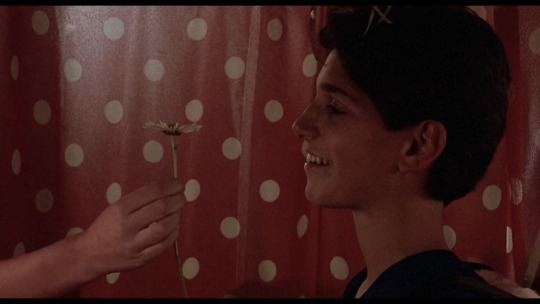
Daniel really is at a dance/ball in disguise and receives a flower from a girl who recognises him through said disguise, it’s unbearable! It’s adorable! I get it Ali, I fucking get it!
Daniel’s main journey within this – apart from not getting killed by karate thugs (love u Johnny <3) and kissing Ali – is to learn from Miyagi. He’s not necessarily a full-on feminine fairytale archetype at this point, although there are fun things to pull out of it, mainly in the context of later films and Cobra Kai: the subtext of karate and how that builds throughout all the stories, the red clothes, the themes of obsession, his being targeted by boys whose masculinity is more than a little bit toxic and based on shame… more on all that coming up.
He doesn’t technically get a home until they build him a room at Miyagi’s place, but he definitely leaves the woods at the end of this one, trophy lifted in the air after being handed to him by a tearful Johnny and all.
And then they made a sequel.
4. The Karate Kid Part Two: Not Out Of The Woods Yet
Daniel’s won the competition, Kreese chokes out Johnny for daring to lose and cry, more life-lessons are given (for man without forgiveness in heart…) and Daniel and Ali break-up off-screen, confirming that TKK1 was not really about the girl after all, which, despite Daniel and Kumiko having wonderful chemistry, is also an ongoing theme. Daniel enters the screen in The Most Baby-Blue Outfit seen since Tiana’s dress in Princess and the Frog? Or that dress in Enchanted? Maybe Cinderella’s (technically silver, but later depicted as blue)?
(Sidenote: At everyone who says Sam ought to wear a callback to that suit, you are correct and sexy).
Surprise, Miyagi’s building him a room.
Double-surprise, Miyagi needs to go to Okinawa.
Triple surprise, Daniel reveals he’s going with him, because he’s his son dammit.
The Karate Kid Part Two is maybe the least Daniel-LaRusso-Feminine-Fairytale-Protagonist of the three, because it’s not really his movie. Daniel runs around with Kumiko (aka the most beautiful girl I’ve ever seen), continues to be The Best Non-Toxic Boy a middle-aged Okinawan karate master could ask for, lands himself another Built Karate Rival (twice is just a coincidence, right? Right?), and eventually doesn’t die while wearing red again – twice: When Chozen almost strangles him to death at the Miyagi dojo and then during the final fight. The Saving Of The Girl (both the little girl in the storm and Kumiko) actually puts him in a more traditional masculine space than the previous movie did, even if the main theme of the film is about compassion and kindness and by the end, once more the boy whose masculinity is built on rockhard abs and matchsticks is on his knees. Daniel just has that power over big boys. It’s called kick/punch them in the face hard enough that they see stars.
There’s an aside to be made here about how much Daniel really is an observer in other peoples stories in this, although he is the factor that sends both Chozen and Kumiko into completely different directions in life (Chozen and Kumiko main characters when?) Anyway he comes out of it presumably okay, despite being almost killed. Maybe a few therapy sessions and he’ll get over it. Too bad Terry Silver is lurking around the corner…
5. The Karate Kid Part Three: The Big Bad Wolf
Alright people have written Words about the third movie. It’s fascinating. It’s odd. It’s eye-straining. It’s like olives – you’re either fully onboard the madness or it’s too off-putting for you (or you’re like. Eh, don’t see what all the fuss is about either way...). It’s basically a non-consensual secret BDSM relationship between a guy in his thirties (played by a Very Tall twenty-seven year old Thomas Ian Griffith) and a 17/18 year old (played by a shorter twenty-eight year old Ralph Macchio).
Also recently we got more information on Mr. Griffith’s input on the uh… vibes of the film. Apparently it wasn’t just The Sweetness of Ralph Macchio’s face, the screenplay (whatever that amounted to in the first place – release the script!), the soundtrack, the direction to not tone it down under any circumstances, the fact that Macchio categorically refused to play a romance between himself and an actress who was sixteen, no: it was also TIG coming up with fun ways to torture Daniel’s character and suggesting these to the director. Clearly everyone has fun hurting Mr Macchio (including Mr Macchio).
The point is that aaallll of that amounts to that Intense Homoerotic Dubiously-Consented-To D/s subtext that haunts the movie and gives a lot of fun stuff to play with. It’s also a film that – if we’re analysing Daniel along feminine-coded fairytale lines recontextualises his role in this universe.
The Fairytale goes topsy-turvy. Through the looking glass. Enter Big Bad Wolf stage right. Karate is a metaphor for Daniel’s bisexual awakening.
“Oh, when will an attractive man touch me in ways that aren’t about hurting me?” he asks after two movies of being hurt by boys with rippling muscles. “Why do men continue to notice me only to hit me? Do you think wearing red is making me too noticeable? Anyway, Mr Silver looked really good in his gi today.”
Daniel’s diary must be a trip.
#daniel larusso#the karate kid#cobra kai#ck#johnny lawrence#cobra kai meta#my writing#part one of three#some comparisons to matrix and rocky because I love to talk about those#terry silver
92 notes
·
View notes
Text
Inventiveness, human ingenuity, and imagination are far more important than an expensive bag of cheap parlor tricks.

“The Matrix Resurrections” is a mixed bag that is more heavily packed with computer graphics and special effects than human content.
The Harold Doc Edgerton reference in the scene with the bullet through the apple did great justice to the father of stroboscopic photography’s original composition; this was my favorite combination of technology/filmmaking/art history within the fourth installment in “The Matrix” film franchise.
In a very similar way to waiting years for the new Tool album, high expectations were placed by me on such a long awaited film. In some ways “The Matrix Resurrections” satisfied these anticipations for something inventively extraordinary, such as the use of special effects combined with computing power.
However, where the film let me down was by omitting the return of Laurence Fishburne and Hugo Weaving in exchange for replacement representations in a way that did not add up to justifying the need for such a switch. Antiquating two vital characters’ original representations to post-production archive footage is a bold move when the replacement characters have flimsy character development. Having Fishburne and Weaving reprise their roles as Morpheus and Agent Smith would have provided much needed grounding to help taper down the scattered premise. The plot line also seemed to have an attention deficit component that wherein it is nearly incoherent and overshadowed by a preoccupation with special effects and computerized enhancements. The collaboration with a video gaming outfit is certainly unmistakable to miss. Although, the augmented reality feel is certainly in line with all of the recent metaverse hype in general.
On the other hand, I still have the scoring snippet of Jefferson Airplane’s “White Rabbit” and the imagery that accompanied it with the blue pill and red pill reference bouncing around in my head, and that was another area in the film that did its job very successfully!
Lana and Lilly Wachowski do a great job diversifying their film actors to an extent that it seems a huge amount of focus and energy was placed on the task of making the film as culturally and gender diverse as possible. If only the colorful array of cast members could have been given a richer script and more dialogue to bring each role to life. Often each character helps to paint in a backstory from previous films in the series, but it never culminates to a level that weaves it all together into a gratifying climax. Instead every enticement is a broken shoe string that falls lifeless back into the box. The dead strings never come to life enough to animate the sneakers to a kinetic rhythm that gets the stories cornucopia of dynamic fruits into the same basket. The viewer leaves the film screening with a bin of smoldering half-eaten fries instead of a contemplative mind pondering over the mysteries of the film and relishing over a picture that left one reeling for more. The film tried too hard to make an embedded political statement that it lost its humanity in place of punchy graphics and commercially polished one-liners. A precarious undertone permeated the film atmosphere and undermined any potential for something more meaningful to occur that could have brought it to a transcendent level that all great films reach to mark their rightful places in the historically timeless film genre shared by the likes of “Cloud Atlas” and “Matrix Reloaded” for example. The one two punch combo of “The Matrix” and “Matrix Reloaded” did the idea justice. In my humble opinion the series could have ended at its strongest with the first two films. The latter two films have been over hyped lucrative fluff pieces void of the ingredients that brought the Plato’s Cave concept inspiration to the pinnacle of mass entertainment meets philosophy.
The film is worth viewing at least two times and has some key moments that live up to the lineage of the great film franchise, but fails to fill its over two hour running time with a captivating story. Even the main actors who are highly respected by me, are not given a high enough caliber of content material to work with, which fails to allow Keanu Reeves and Carrie-Anne Moss to shine as they truly can.
I still remember how satisfying it was to screen the first “Matrix” film in the theatre in 1999. It seems prophetic in hindsight upon contemplating all that has come to pass on our world’s stage and in our actual lives since then. Perhaps the most recent installment of “The Matrix” is extremely true to the chaos found now in our modern lives and so in this regard it holds a mirror up to realize this all too well.
In this unprecedentedly crazy time period, in our history in the making, we need more truth serum instead of more hollowly glitzy puff pieces. Feeling slow and meticulously drawn out similar to the film “Inception” only without the unique and well executed plot hobbles this film in all the places where it should have accelerated to give it the edge it needed to pull off such a multifaceted story. Compound this short failing with the budget expenditure, and one begins to wish more thought had been realized in the final film version than money spent in burnishing the film with a sleek patina to enshrine not much within. The nothingness embedded within the subtext of this film makes some deceptively clever 1 minute advertising commercials seem like Rembrandt paintings.
“The Matrix Resurrections” felt more like a new video game flexing its superior graphics capabilities in 2021, but it lacks the soul of a game like Castlevania 4, which used the graphics of its time to tell a captivating video game story on the Super Nintendo platform back in the early 1990’s. Now, graphics are better than ever, but where graphics technology excels, soulful imagination is lacking. Inventiveness, human ingenuity, and imagination are far more important than an expensive bag of cheap parlor tricks.
—Cavia Platolopogus
#matrix#the matrix resurrections#thematrix#film review#plato's cave#cloud atlas#Laurence Fishburne#keanu reeves#carrie anne moss#the wachowskis
9 notes
·
View notes
Text
Movie Review... The Matrix Resurrections

(2/5) Watched this twice in the last two days. The 2nd time took a lot longer because I had to keep pausing and taking notes. In a nutshell, in a flash summary...this is the Matrix for Gen Z'ers. The generation that can be summed in some instances as taking something that has already been done and calling it there own (for example countless dances and songs from the 80s and 90s redone, rediscovered on social media). That's what this movie feels like. It tries to do what three films did and then finish with something new and it fails and is bland.
Questions and plot holes are not foreign to the matrix franchise but when those questions are spread and explained in three films vs one; it's hard to process. There was more that I disliked than I liked.
The action was lackluster compared to its predecessors. I am not sure if this was done purposely for this new story or was this something due to COVID. Either way the final product did not reach the standard. I hated the shooting sequence too. Literally all at close range but no one got shot? I didn't like them breaking the 3rd wall too. That is always a key give away of a money grab Hollywood sequel. It was disguised as the comedic element of the film but was delivered as a load of cheese.
Lastly, the vagueness in the explanations about the returning of certain characters, terminology and settings. Zion's demise was unclear to me as well as the return of Smith. Niobe's return was good to see but then for her grow old to be just like Captain Roland doesn't make sense for what the character went through in the older films. There was a lot more too question but it's not worth it (check out my film notes at the bottom).
There were a few things I liked. The scene where Trinity yelled Neo's name gave me chills and the result of Neo going to the machine city (no spoiler). But that is about it.
This doesn't necessarily tarnish the other films but it’s definitely not needed either.
To find out if his reality is a physical or mental construct, Mr. Anderson, aka Neo, will have to choose to follow the white rabbit once more. If he's learned anything, it's that choice, while an illusion, is still the only way out of -- or into -- the Matrix. Neo already knows what he has to do, but what he doesn't yet know is that the Matrix is stronger, more secure and far more dangerous than ever before (rottentomatoes.com).
Notes and Questions (Things I Wrote on my Second Trip)...
Modal - Simulation used to Evolve programs Programs = Digital Sentience?
Rehashing of older films
Morpheus referred to bugs as a sentient and she did not correct him? But she isn't
Morpheus is a program that has to find Neo
Shoot at point blank range and missing?
Are the modal and game the same thing?
Neo is trapped within a new matrix with trinity and they can't remember anything. Neo is a game creator in the new matrix and the game he creates is of his memories. Basically the first 3 films. The game is popular in the new matrix. In the game neo has created a new morpheus a program to free him.
Constantly referring to the themes of the original films, breaking that 3rd wall was not done "smartly" Matrix 4 video game = matrix 4 movie. Pitch meeting...matrix for Gen Z
Agent Smith Neo boss?
Analysts is the new Architect
Fighting and action sequences are subpar to predecessors (unsure if that was done purposely or due to COVID)
Battle in the office? Real...next game/modal. Agent Smith?
Bots vs Agents?
Mod morpheus was created to free him but Smith was also involved in the coding of Mod morpheus
Synthients?
Zion was always set up by machines...IO set up by people?
Very vague what happened to zion... during the purge, creation of new matrix, did Zion get destroyed
Smith explains his arrival being that from the analysts...but morpheus spoke of something different?
Analysts slow down mode?
New analysts wants to harness emotional distress instead using logic and equations as control like the architect
Niobe grew old just become Captain Roland
Tati?
Agent smith turning into that random guy?
How does trinity access skills neo once had?
#matrix#the matrix#the matrix resurrections#movie review#film review#action#neo#trinity#niobe#keanu reeves#carrie anne moss#jada pinkett smith#matrix 4
9 notes
·
View notes
Text
The Matrix Revolutions
The human city of Zion defends itself from the invasion against the machines as Neo fights to end the war on another front while opposing the rogue Agent Smith.
The Matrix is one of the most interesting franchises that I've watched. In one hand, it has a very original concept with great worldbuilding and a fantastic start, but in the other is the very poor execution of its concept to the point where the world becomes confusing and convoluted. It felt like the Wachowski sisters had no idea how to end this franchise, or just said fuck it, and decided to present one of the most confusing endings I've seen in a franchise because it would give them time to actually create a good ending for the series.
Besides the fantastic second act of this film, the whole film feels flat from nearly every perspective. The writing is clunky and all of the emotional points are a massive miss. The story becomes convoluted and filled with conveniences that do not make any sense. For example, how does Neo have his powers outside of the Matrix? That is never answered and the writers never attempt to answer it. The fighting in the Matrix is now incredibly over the top and almost comical. Before there was a groundedness to their fighting even though they were defying physics, but now they are flying in the air like superman. I will say the siege of Zion was a lot of fun to watch and was the best part of this film.
Even the acting in this film felt really weak. Don't get me wrong I love Keanu just like everyone else, but he is incredibly flat in this film. Every line sounds exactly the same with no variation between them. Laurence Fishburne and Carrie-Anne Moss both look really bored in this film. Hugo Weaving, know that this film was going to be a disaster so he went with a very over-the-top performance, which stood out among the dull performances among everyone else. I must give credit to Ian Bliss who did really well as a human version of Agent Smith. He nailed Weaving's mannerism and speech as the iconic character.
The technical aspect of this film is also really well done. The visual effects have aged really well. There are several shots of really good cinematography which I enjoyed. The soundtrack again is killer. The aesthetics are awesome, but I just wish everything else live up to it.
Overall, this film is a mess from nearly all perspectives. Its story is convoluted, its acting is dull, and its action is laughable. If it weren't for the siege of Zion, then this film truly would have been a disaster.
I am giving The Matrix Revolutions, a C.
#film#cinema#movies#filmmaking#cinephile#film stills#cinematography#filmmaker#film community#film review#movie review#film critic#movie critic#blockbuster#science fiction#the matrix#neo#wachowski sisters#matrix#keanu reeves#laurence fishburne#carrie anne moss#hugo weaving#ian bliss#the matrix revolutions
3 notes
·
View notes
Photo

The Matrix Resurrections
“The Matrix Resurrection” has a lot of cool ideas, but this movie never commits to its own identity.
Thomas Anderson is now a wealthy video game developer of the game, The Matrix. Although he’s well off, he has a myriad of psychological problems that makes it hard for him to distinguish between real life and fiction. To the world, The Matrix is just a game, but to Thomas, it’s something much more. He keeps meeting a vaguely familiar woman named, Tiffany, and she just might be the key to figuring out what’s going on.
For whatever reason, this review has been really difficult for me to write. Maybe it’s because I don’t really see why people are calling this movie worse than the original sequels. Don’t get me wrong. I do think this movie isn’t amazing, but I don’t think it’s without merit. For starters, the visuals are incredible in this movie. I know there have been almost twenty years in between this and the last Matrix movie for advancements in special effects, but this movie is creative with it. For example, there are lots of scenes in the first act where I was doing double takes because the reflections would show a completely different person. It had me doubting what was real or not, just like how Thomas Anderson was feeling. It was a clever way to get me to relate to Thomas’s struggles. There’s only really one scene where the special effects were bothering me. That scene was the one where Neil Patrick Harris’s character is moving way faster than everyone else. Time slows down around him and he’s giving this evil monologue to Neo. The way he moves in this scene is reminiscent of Windows XP errors where you could drag a program around to make this weird duplicating effect. It just wasn’t very pleasing to look at. I’m sure they could’ve just stuck with having him move naturally. I don’t see why this was the choice they decided to go with. This new version of the Matrix is really cool to see. It’s modern and clean. It truly feels like it has updated with the times. It also incorporates the massive changes the real world has had in twenty years into the simulated world that makes sense. I was super into watching the simulated world scenes because it just felt like a refreshing step forwards from the old Matrix-style. Jessica Henwick is able to stand her own amongst the veterans of cinema with ease. I loved watching her scenes because she has such a fun personality while still maintaining that leadership quality. I’m definitely looking forward to seeing her in more movies. A lot of people have been complaining about Neil Patrick Harris’s performance, but I personally liked it. Maybe I’m biased because I like anything he’s in, but I thought he was fun in this movie. I still did have problems with a lot of the changes. I like Yahya Abdul-Mateen II in a lot of movies, but I don’t know what they were doing with his character. I would’ve been cool with making him an entirely new character, but he’s, instead, this hybrid of Morpheus and Agent Smith. It’s just a weird choice that doesn’t do much with the new implications. Jonathan Groff is one of my favorite parts of “Hamilton”, but I don’t think he works very well in this movie. First off, he’s trying to do his own thing separate from Hugo Weaving’s Agent Smith. While I admire trying to establish his own version of the character, I don’t think his version was menacing like the previous. I think the most volatile aspect of this film was how meta it was. On one hand, I thought the decision to turn the events of the original Matrix trilogy into a video game was fun. It was a smart way to tackle the impact that the original movies had on audiences and how they affected those who made them. On the other hand, there are too many moments reliant purely on their nostalgia for them. It’s weaponized to a nauseating degree. I wanted more of the cutting-edge commentary and less of the self-masturbatory reveling. All of these highs and lows accumulated into a pretty average movie-going experience for me. I don’t think it’s as divisive as “Star Wars: The Last Jedi”, but that’s probably because I personally don’t have a huge attachment to this franchise.
★★★
Watched on January 10th, 2022
#The Matrix Resurrections#December#2021#Action#Science Fiction#Adventure#Fantasy#R#Lana Wachowski#January 2022#3 stars
2 notes
·
View notes
Text
Writing Betrayal
Writing Betrayal
It’s the third act of the story, your heroes are in the fight for their lives (sometimes literally) and absolutely nothing must go wrong. But wait, someone close and important has decided to change sides.
CURSE YOUR SUDDEN BUT INEVITABLE BETRAYAL
The horror. The gut punch. The characters are now in even more dire straights. People may be dead.
Now, how do you, as an author, go about writing this to get the most reaction out of your audience?
Firstly, you have to write the character into the story.
No one is going to care about the third cousin once removed if he never appeared in the story before this betrayal scene. Your betrayer should be one of the main characters of an ensemble, or someone your main characters hang out with quite a bit.
The main characters trusted this character, we should too. They were friends. The reader should feel like this character is their friend.
Example 1: Cypher from the Matrix. Cypher was one Morpheus’ crew on the Nebuchadnezzar. Morpheus trusted him enough to have him handle setting up missions and standing watch keeping an eye on the Matrix. During the film, Cypher makes several come ons to Trinity, and expresses doubt to the new guy, Neo, about leaving the Matrix. (Foreshadowing) and is later shown actively betraying Morpheus to Agent Smith. Without those few scenes where Cypher is the ‘star’ of the movie, the betrayal wouldn’t have been as impactful.
Example 2: Elizabeth Swann from PotC: Dead Man’s Chest. Elizabeth is one of the heroes of the movies, if not the Heroine of the original Pirates trilogy. They follow her journey from a rather spoiled Governor’s daughter to becoming a pirate captain in her own right. We are constantly with her. She’s the good guy! And then, the kraken comes, the sailors have to leave the Black Pearl as the Kraken is after Jack Sparrow. And Elizabeth makes a choice, to betray her friend, the one in the last movie she stood between him and certain death and she MANACLES him to the MAST.
This betrayal of her own ideals and doing what is expedient over what is right is when Elizabeth truly becomes a pirate and has to spend the next movie fixing her mistake to assuage her guilt (Going into the cave of World’s End) before she can return and be willing to live on land again.
Secondly, give the betrayer a valid grievance.
When the betrayal pops out of nowhere because it’s an expected trope of whatever genre you’re writing, often the motivation of the betrayer is completely glossed over or not mentioned at all.
Your betrayer is the hero of their own story. They need to have a reason for doing what they are doing. It doesn’t really matter the reason. It can be as petty as they like, what matters is this reason is important enough to them that they are will to go against the people who love and care for them to attain it.
Of course, the betrayer may have never actually loved or cared for these people and just pretended. Valid option! Or maybe the betrayer isn’t betraying them at all and this is part of a grander scheme. Also valid option!
But there has to be a reason. “You didn’t pay me enough attention, give me the reward I thought I was due, I didn’t get the girl” are all petty but valid reasons.
Example 1: Cypher. Life outside the Matrix wasn’t what Cypher envisioned. He didn’t like the clothes, the food, and the accommodations. He wanted to go back into the Matrix even though it was fake. He was willing to kill everyone on the ship to do so. (Whether or not the machines would actually do this was never explored, though implied heavily they would betray Cypher in turn.)
Example 2: Elizabeth. She is facing the proverbial rock and a hard place choice! She either betrays Jack and leaves him for the Kraken and the crew is almost sure to survive. Or they take Jack with them and the Kraken ignores the Pearl entirely and comes after the life boat and they most assuredly all die. One life, or everyone’s life.
Thirdly, we need to like this character enough that we are rooting for them to not betray the main characters and be part of the team.
Likeability is a very alchemical thing. But if the character comes off surly, whiney, or downright skeevy (especially to the female audience) then it is less likely the reader is going to want that person to be part of the gang.
Example 1: Cypher. Okay, Cypher is not the best of examples because Cypher is honestly a bit skeevy. He hits on Trinity when it’s pretty clear she’s told him to back off already. However, when he’s talking to Neo about “why didn’t I take the blue pill” you and Neo don’t know if he’s just talking out his rear end or if he really means it. Cypher is trying to be friendly even.
Example 2: Elizabeth. She’s the heroine of the story. She’s done awesome things like parley with pirates, stab a pirate, sword fights, fake fainting to cause distractions. Basically, she’s been pretty cool the entire two movies as she sets off to save Port Royal/Will Turner in her noble way. This is excellent motivation!
Lastly, there should be some foreshadowing. OMINOUS MUSIC
This is kind of a culmination of everything before. Basically, you need to set up your betrayal. In order to set up the betrayal, the reader needs to spend time with the characters and they have to have a good shown motivation to betray the heroes. And we don’t want the betrayer to be twirling their mustache throughout the story because that doesn’t make the betrayal a surprise! There should still be clues. Things perhaps should be a bit off. Maybe there is a conversation about feeling underappreciated or they made the wrong choice. Maybe the character shows mild resentment. Or the heroes almost catch them in the act of doing whatever they are doing to betray them but the betrayer has an excuse to hand.
There needs to be something that the reader can go back through the story and go “ah, I see it now” before they’re finished.
Example 1: Cypher. Cypher and Neo have a conversation about Cypher’s thoughts on taking the ‘red pill.’ Cypher tries to frame it in such a way he’s encouraging Neo in the “we’re in this together” group think mentality. (Men do this a lot by assuming your thoughts on a subject when it is their thoughts they’re trying to impose on you in a bid to make you feel included.) You can’t tell at this point if Cypher means it or if he’s trying to figure out what Neo thinks or if he’s just talking. It is only later with the dinner with Agent Smith you find out he really does want to go back into the Matrix.
Example 2: Elizabeth. Elizabeth’s betrayal was foreshadowed more subtly than Cypher’s. Mostly by using a romance subplot where Elizabeth is torn between her love for Will and the feelings she has for Jack. The compass that doesn’t point north is the plot device here. (And the fact that Jack does return those feelings.) It’s her frustration with herself and in fact, with Jack combined with the intense need for everyone to survive, that has her throwing morals to the wind and betraying her friend Jack (and making Will think she no longer loves him because they don’t end up talking like adults. Ugh.)
There you have it, four pieces of advice to make your betrayals come off with plenty of emotional impact for the reader so it feels satisfying. This is, of course, all from the point of view of the good guys are being betrayed. If someone from the other side is betraying the bad guys, that’s a different kettle of fish entirely.
21 notes
·
View notes
Text
who i mean when i talk about the white man
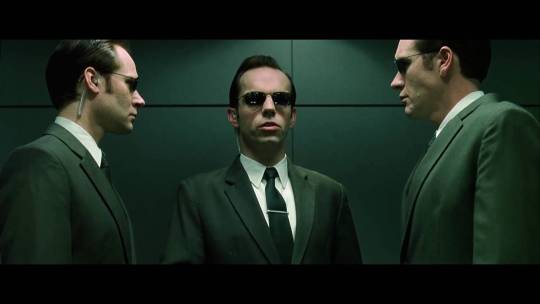
the beauty of the agent smith character from the matrix is that he can inhabit anyone, meaning that anyone can become him.
this is one of the ways i think about the white man.
usually, though, when i talk about The Man, i mean the high level operatives of the state & industry...judges, gatekeepers, bosses. but it also includes the more anonymous enforcers: cops, soldiers, etc... these are people who can bring the hammer of the state down on you if they so choose. they have chosen to become the hand of the state..the mouth of the state..acting on its behalf, doing its work, etc.
is america the white man’s state?
well it was founded by 100% white men:
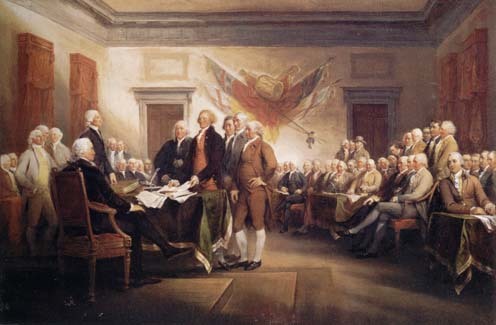
it was founded for white men. it was not for white women (who couldn’t vote, etc.) or black people (who were enslaved, 3/5ths of a person). it was not for the people who were already living where these men were trying to form their country: native people weren’t even allowed to become citizens of USA until 1924.
you can argue that the white men who ran this place (and who started institutions like the major universities, etc.) have gradually let other people in - women, black people, jews, immigrants, etc. but the rules & values of the american government, of major universities, of news organizations, etc., are in almost all instances the rules & values of those original white people & the white people that have been running those places ever since.
even things like tech products (like this website!) that are meant to be for anyone to use, where technically anyone can work, are the white man’s tech..primarily built & founded by white men..primarily in the white, western tradition of high tech. almost every discipline you can get a degree in (like computer science) was invented & founded by white men working within universities run by white men. this is the most basic sense in which i mean these instutions belong to the white man. he founded them. they are his creations. he continues to create them - publishing the news, keeping the university running, keeping the government running.
you may want to become a part of those institutions - to be in government, to work for a major tech company, to be a cop or a teacher, to be recognized in the art or business world, to get tenure at a major university, etc. ..which is your business and you do you. right now i am writing in the white man’s language (english), using his technology (a computer, the internet, this website), and i, too, try to get my hands on his money (dollars) if at all possible lol.
not all white men are agents of the white man’s state, but most of them (especially if they’re straight and/or christian) can become a part of it. all of them benefit from it (you’re just not as likely to get killed by a cop during a traffic stop if you’re white. this is just reality.).
almost anyone (with the right papers, with the right skin color) can become The Man...when you as a white person call the cops on a black person, in that moment, you are The Man. when you as a white person try to police someone else’s behavior..or question whether they are in the right place etc...in that moment, you are The Man. if you’re gatekeeping your favorite hobby or industry, in that moment, you are The Man. that’s the beauty of the agent smith character in the matrix - agent smith can execute the full power of the state (ie, visit death on you) and anyone can become him.
it’s much harder (in many cases impossible) for certain “others” to enter various parts of the white man’s world. but it’s possible! look at your black & women cops. look at your colin powells and condoleezza rices..look at all the queer people who are allowed to rise to the top. which is why i think of being The Man as a condition, not as something essential about who you are. of course some people really are The Man on the inside lol - they were born into it or have adopted it or really think they know better and can’t see any other way. waddaya gonna do.
many white people especially are confused about the things that make up white culture. it’s especially difficult to understand because part of white culture is insisting that its culture & ways are universal. so every time you’ve heard a white man say “this is human nature” or “all people do this”, that in itself is white culture. white culture claims to be a neutral culture and a universal culture. but the more you learn, the more you discover that things you might have thought were neutral or universal are actually historically, geographically, & culturally specific to whites/westerners..they are things that were invented by whites/westerners.
here’s one example: many people think that some form of jail/prison/confinement of a person who did a bad thing is universal, or at least very common throughout time and in many parts of the world. but jails/prisons were invented in the west and in fact through much of the west’s history, these were not the main or preferred ways to punish people. michel foucault’s book “discipline & punish” is a good history of the invention of the prison.
when i say “a product of white culture” or "western culture”, the white reader might think “well i’m white and it’s not *my* culture.” that may be true! now imagine the whitest of the whites: your new england snobs, your english posh snobs, the good ole boys who run your town or state, your oppressive church leaders, an elected official who hates you & lies to you, a smug know-it-all educated technocrat (it might be you!), a karen, a cop, the trumpists, the polite skeptic liberals who are always telling you to temper your expectations, the shmucks who make the sexist, dumb hollywood movies, alllll the gatekeepers... their culture, the way they do things, the things they value, that is white culture. it varies. the white conservative’s culture is not the same as the white liberal’s culture, but they do have some things in common, like wanting to keep america going. both of their cultures are white cultures.
these whites are the people who make the culture that so many of us have grown up in - not just those of us in the west. the white culture machine includes academia (which produces scientific knowledge, histories, & the social theories & policies that many reforms are based on), tv, movies, the music industry, the art world, fashion, wall street, the tech industry, the news, professional sports, the politicians & cops (that are so often the content of the news), schools, white churches, most philanthropies, and all kinds of national (& many international) interest groups (ngo’s, advocacy groups, etc.).
these are institutions that (like the US government) were founded primarily by white men and have been run primarily by white men since their founding. they have all the money. they have power - whether it’s commercial power, political power, power to shape the national conversation, power to define what is true (only western science can say what’s true, according to western science!), power to give you a job or take it away, etc.
if you want to be “at the top of your field”, you are almost always meant to strive to join one of these white institutions (mostly white mens’ institutions). you might say “well there’s nothing particularly white about them..it’s just a news company..or an ad company. they’re just doing business.” but when i say white in this context, i mean that the people who founded them were either 100% white or mostly white. the people who have always run them have been either all white or mostly white, and the people who run them now are either all white or mostly white. in this sense, they are the white man’s institutions.
it can be hard to understand that because they are often the national or otherwise “official” thing: national news, or the biggest national/international companies, the top national/international universities. they certainly sell themselves as “the official thing” because it doesn’t sound great to say “the official newspaper of the white man.” and they want to be the official thing. they want to be the top x in the world. that’s an important white, western value as well - wanting to be the thing for everyone. the UN was not the dream of all peoples. it was the dream of some specific white, western people who created it.
here in america, a white man’s state, we grow up in that state’s schools, learning the history it wants us to learn. we watch its tv and listen to its music. we read its news and use its tech. we & our ideas..many of the things we think are true..many of the things we value..have been installed in us by that state and its various mouths (the ones who teach its desired history, tell you how you should look, what you should want out of life, what you should buy):
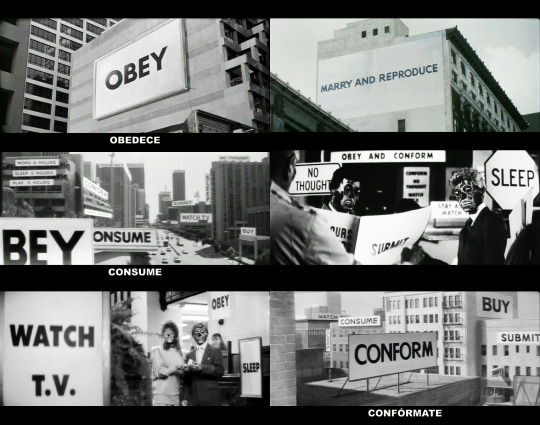
(above graphic from the movie “they live” (1988))
but we do all have a choice about which aspects of the white man’s culture we choose to adopt..we have choices about which of his values (progress, superiority of humans over nature & animals) we adopt..choices about which books we read & which movies we watch. is the matrix white man’s media? it used to be, but the wachowskis left the club ;). now it’s white trans women’s media :}
one final thing: is everything that white men do or think part of the white man’s culture? are all white men The Man? i hope that this post has made clear that i think the answer to both questions is “no”. i hope i’ve also made clear that non-whites and non-cis-het-men can very much be The Man or agents of The Man at times, or even their whole life. i’m not saying that it’s necessarily bad or necessarily good here, i just want us all to be honest with ourselves about who we are & whose work we’re doing.
a related question: if you start a club and you’re a white man, is it the white man’s club? i think it depends..it might be. do you work within the white, western tradition? do you accept its assumptions (capitalism is good, meritocracy is real, etc.)? do you further its culture? do you support its work? do you subvert it (by insisting that the club & its ways & rules are co-created with women, POC, etc., as real equal co-founders, for example)? do you use your position as someone the cops might believe, or someone the manager might listen to, to get your way & get what you want? ..to get someone else out of the way when you want? you might be The Man!
we can debate specifics - whether industry x or person y or instution z or cultural value n is white, but for me it comes down to this: was the value/government/institution founded by whites/westerners? has it been run & carried forward by whites/westerners? you can also ask whether it primarily benefits whites/westerners (who are allowed to rise to high positions or allowed to not be as likely to be killed by the cops, etc.) and whether it promotes the values/goals of The White Man. if a judge, a cop, an elected official, a principal, a high level church leader, a university president, and a corporate leader can all agree on it, then in my book, it promotes the values/goals of The White Man. an example of values that might fit this bill include an agreement that we should not try to dismantle america, for example. that one should work within the system...that industrialism is the way to go...etc.. primarily these are pro-establishment values. and “the establishment” is another way that i think many people talk about the white man’s culture & institutions.
anyway, this post has gone quite long. thank you for staying with me till the end. i hope it’s provided at least a rough sketch of what i mean when i talk about the white man or The Man and i hope it’s given you something to think about. i apologize for not going into the history of the usage of “The White Man” or “The Man”..i started writing this on a whim & haven’t done a historical dive. please forgive me for that. thank you.
2 notes
·
View notes
Text
Matrix Pill 2020
The Matrix has you…
The cultural overview over "The Matrix Trilogy" and how it foresaw the social trends.

"The Matrix" trilogy by the Wachowski brothers is the most iconic and groundbreaking movie trilogies in cinema history. Terms like "The red pill", "Dessert of the real", "There is no spoon", "Follow the white rabbit", "Why, Mr. Anderson? Why?" and many other phrases from the film became the golden quotes of the new millennium, shaping the entire culture of the "generation Y"… also known as "the millennials". "The bullet time" effect with fancy acrobatic moves and bullet waves turned into the most quoted gimmick for decades in action films, parodies and video games. The slow motion has never been so cool and slick, as it was after "The Matrix", not to mention sunglasses at night and dark looks with fashionable black leather tailored coats.
Its been 21 years since the theatrical release of the first "The Matrix" film. It came out in November of 1999 (the most revolutionary year in cinema history, since it is the release year of such groundbreaking hit titles like "Star Wars: Episode I. The Phantom Menace" by George Lucas, "Fight Club" by David Fincher, and "The Matrix", of course, by the Wachowski brothers). Four years after the great success of the film, "The Matrix" was reloaded with two worthy sequels: "The Matrix Reloaded" and "The Matrix Revolutions" — turning a movie franchise into a full-time trilogy. There was also "The Animatrix" — an anthology of animated short films set in "The Matrix Universe" directed by highly acclaimed Japanese animators, and a video-game "Enter the Matrix" which told a story that went parallel to the story of sequels, explaining some of the unanswered questions in the films. Thus "The Matrix" franchise has become one of the first inter-media franchises where all available storytelling formats told one epic story from different angles and points of view. And unlike other attempts of creating such inter-media franchise around movies (like it was with "Star Wars Expended Universe" or "The Terminator" franchise) it wasn't just pure merchandising and cash-grabbing schemes with questionable product quality having a famous brand logo on it… no, '"The Matrix" franchise was one well thought out project and story from the very beginning, created and curated by the Wachowski brothers. Nothing more or less.
In the year of 2020 "The Matrix" is being reloaded once again with its new instalment being in production. Internet is filled with shaky mobile phone behind the scenes footage of "The Matrix 4". We see Neo, played by actor Keanu Reeves and his stunt double, jumping of high buildings and riding fancy motorcycle with Trinity, played by Carrie Ann-Moss, while the streets of San-Francisco are being turned into a chaotic war zone with explosions, car chases, extras running all over the streets and helicopters flying.
Usually such big blockbuster film productions are being held in secret in order to prevent unnecessary leaks and story spoilers… most of the extras and crew members don't even know what movie they are filming up until the very end. During such big productions fake movie titles are made. But this time, as it seams, filmmakers don't really care about production secrecy, as actor Keanu Reeves and film director Lana Wachowski keep on hanging out with random people on a street during the filmmaking process. What is it? A new viral social media format of film advertising? Or the new way of entire filmmaking approach? Or maybe both?
Either way — Lana Wachowski is the visionary artist that is going to bring something fresh and unexpected into the cinema format and into the new "Generation Z" culture. The Wachowski brothers have foreseen the future with "The Matrix" film almost in every way possible… and I'm pretty sure they are going to do so again. They spoke of cyber-crimes, data privacy and internet control long before Edward Snowden incident, WikiLeaks, Anonymous group, social medias and etc. They showed aircraft controlled by so called "terrorists" hitting skyscrapers years before 9/11. "The Matrix" also tried to warn us about the dangers of virtual realities, and here we are 20 years later using VR systems and spending our lives in endless MMO RPG games (by the way, "The Matrix" franchise even had its own MMO RPG video game "The Matrix Online"). The virtual values have become much more valuable that the material ones. Bitcoins and Facebook likes are considered to be much more precious then real money and even gold by many. Instagram pages are viewed as the only true portraits of their users, however bright filters, happy faces, flattering camera lenses and photoshop have nothing to do with reality. It is merely a "Residual self-image", as it was named in the film, "A mental projection of your digital self". The person sees himself whom he wants him to be, not whom he really is.
And I think that this topic is the most overlooked topic by critics and contemporary culture scholars.
Just think about it — the Wachowski brothers are the physical manifestation of their own concept of "Residual self-image", as both of them saw themselves as someone different. Both brothers were men, but they considered themselves to be women. Their physical reality didn't match with their mental projection of virtual self. Thus they had to do surgeries and go through sex change procedures. The Wachowski brothers are officially sisters. Nowadays in 2020 it is a common practice that can't surprise anyone, however in 1990s during the production of the first "The Matrix" film it was a big deal… so big that Wachowski brothers had to rewrite the screenplay. In the earlier drafts of the script there was a fully flashed out transgender character. She is still present in the final film, but her role and concept has been reduced. Character Switch — portrayed by Belinda McClory — was a transgender, and her name "Switch" meant too illustrate her constant transitions from one form into another, as she was a female in the real world, but in the Matrix her personal "Residual self-image" switched her into a masculine male. For Wachowski brothers it was a very important topic to explore, since both of them dedicated their lives to transgender worldview, but in 1990's the film studio and producers thought that such concepts would be too confusing for average film viewers and difficult to follow, thus it was all cut out during pre-production. Even their first film "Bound" that featured lesbian love story was met with numerous misunderstandings during pre-production, during its filming and, of course, during its release, since such themes were considered too risky… almost taboo, as they could easily put off many unprepared audiences.
But now… look how the world and culture has changed?! In 21 years everything is upside down. It is almost impossible to find a big blockbuster film or franchise or T.V. series or even a video-game that has no lesbian, gay, transgender, bisexual, pansexual or any other "something"-sexual character. It is true for both "rated R" and "rated M" media and for media oriented for children. Disney's life adaptation of animated classic "Beauty and the Beast" is the prime example… not to mention more.
I must say that unorthodox sexual orientation of characters were always present in cinema, they were never the subject of prohibition and never will be, however before "Wachowski era" their orientation always played some sort of narrative purpose. No character was supposed to be gay or transexual just for that sake of being such. But nowadays we see LGBT characters all over visual media… and the fact of their orientation rarely enhance the story or add anything to it. For the most part it is just being there for no reason other then being there. No wonder we have so many poorly written stories today. "Chekhov's gun" is the key to good storytelling, isn't it? If you put something into a story, it must heave a purpose, because without purpose it's just a filler, a white noise… this means it shouldn't be there at all. And here I'd like to quote Agent Smith from "The Matrix" films:
"But, as you well know, appearances can be deceiving…" — even here Wachowski brothers point out the previous "Residual self-image" topic. "…which brings me back to the reason why we're here. We're not here because we're free. We're here because we're not free. There is no escaping reason; no denying purpose. Because as we both know, without purpose, we would not exist."
Curious… Wachowski brothers were pioneers in LGBT mass-media, yet even they were smart enough to exclude these themes from "The Matrix trilogy", even having a total creative freedom over the sequels, as they knew that it would serve no purpose in their story. Yet they used much more sophisticated tricks to pinpoint their agenda and worldview. Get ready for some hard drugs! Wachowski brothers urged the protagonist and film viewers to take "The red pill" and "Free our minds". They also urged us to fight against all rules and stereotypes, and young generation loved it. In the film it simply meant "rage against the machines", but in our world where this film was "The red pill" for young people, this fight against the established order had much deeper purpose.
Upon the quick view on the lives of the Wachowski brothers over these two decades we can tell that their "red pill" they were giving us, was simply a androgyne hormone for transgenders and their main "Matrix" they were fighting against, was the sexual orientation stereotypes. They succeeded in their revolution, as LGBT themes are no longer taboo in mass-media. But there were also other important cultural topics Wachowski brothers presented with their trilogy: multiculturalism, racial diversity, feminism and even "toxic masculinity" and war against white men and patriarchy… long before these themes became mainstream in pop-culture.
"The Matrix" franchise had always a diverse cast, didn't it? It also has strong and independent female characters right from the start. And it wasn't just a copycat trend to appeal some social minorities, as it happens today. It was the personal philosophy of the authors. However, despite all their diversity and equality, one social group was shown deliberately one-sided. Just think about it. All evil characters in all three films were male and white. Agents are white middle aged men, Cypher — white middle aged man, Merovingian — white middle aged man, Architect — white man, Bane — white middle aged man, etc. Some can argue on this topic, since white men where also on the side of good guys. True, "but, as you well know, appearances can be deceiving…" says Smith. All white men on the good side of the story are… well, questionable. Whom can we name? Councillor Hamann — played by Anthony Zerbe — is a white man… a father figure in Zion, however he is shown to be an irrational and rhetorical weak old man. Comparing him to other leaders of Zion we can easily see his incompetence. Even Neo makes fun of him, pointing out on a fact that Hamann's solid age doesn't make him wiser (and it is the only time in the whole trilogy when the main protagonist ever trolls anyone). Then there is the Kid — played by Clayton Watson — another white man good guy, but he is just an immature naive boy… in "The Animatrix" he in the moment of danger finds no better way out then a suicide… a very questionable role model, don't you think? Who's next? Mouse — portrayed by Matt Doran — once again a young teenager full of sexual hormones and nothing more. There is also Captain Roland — played by David Roberts — and his ship crew, but a single black woman Niobe — played by Jada Pinkett Smith — turns out to be wiser and much more competent then any of them. Meanwhile all non-white and non-male characters are shown in the positive light. Wait… but what about Neo — the one himself — played by Keanu Reeves — he is a white man — the hero of the trilogy. True. However originally "The Matrix" creators wanted to cast Will Smith for the role of Neo, but Will Smith declined the role and chose to act in "Wild Wild West".
In other words Wachowski brothers brought up anti-white men SJW themes in their films long before such topics became mainstream and part of pop-culture. Thus they weren't even noticed by the time of film release. But it is worth mentioning that Wachowski brothers were depicting anti-white men subplots not because they were following some kind of fashion or social agenda like mass-media does today, but because brothers WERE white and men, and they wanted to do something about it. And they did. For real.
However next generation of filmmakers and artists took the Wachowski brothers' personal issues and turned it into a viral trend, changing the culture forever. It can be even said that the modern SJW and LGBT hysteria is the Matrix, created by Wachowski brothers. I wonder, will their new "The Matrix" film change the world once again?.. and how?
Text: Jurii Kirnev
Omnifinery Editorial: Article 003
2 notes
·
View notes
Text
Men in Black II (2002)

Men in Black II might have aspects which technically elevate it above a 0-star rating but it makes you feel so lousy and tries so little to do anything worth your time it earns itself the lowest rating a movie can get. It’s lousy in obvious ways and in surprising ways. You watch in disbelief.
After waitress Laura Vasquez (Rosario Dawson) witnesses the shapeshifting plant-like alien Serleena (Lara Flynn Boyle) interrogate and then murder her boss, Agent J (Will Smith, whose usual charisma is absent) must re-recruit his old partner, K (Tommy Lee Jones) to find the “Light of Zartha" before it falls into the wrong hands.
I don’t know if the writers were so incompetent they couldn’t find something for Linda Fiorentino’s Agent L to do, or the actress read the worthless script and jumped ship. Either way, her absence is the first sign of trouble. You know a sequel has no idea what it's doing when its first move is to undo the ending of its predecessor. It’s all downhill from there. The special effects, for example, are not convincing. The makeup and puppets used are fine but anything CG is sub-par. The worst offender is probably the two-headed alien played Johnny Noxville. Maybe the editor realized how bad it looks, which is why his character just DISAPPEARS halfway through.
There's a scene which encapsulates the entire feel of “MIB II”. I could pick the bit where J and K get flushed down a giant toilet - it's that kind of comedy. Instead, we’re talking about the battle J and K have with a bunch of goofy-looking aliens. One literally looks like living dog poop. In fact, that’s what he’s credited as! After he’s dispatched, K attacks his next foe by kicking him in the testes except - and here comes the joke - the extraterrestrial is a ballchinian! That means his scrotum… is on his chin, not between his legs! Are you laughing yet? What if I told you he’s taken down by a Matrix-like kick, one of many?
It’s awful. Then, we get to the climax. There are at least three endings in a row and none are exciting. The idea was for everything to move so fast you wouldn't notice the obvious voice-over dubs and hastily reshot scenes. You’d think with all the crowbarred product placement throughout they could’ve scraped enough money to give us a proper conclusion, but no.
The only way to be entertained by Men in Black II is to look closely at every plot point that goes nowhere and piece together what this movie might’ve been. Not that there was any hope for it, ever. You’re better off pretending “Men in Black II” never happened. There’s a joke about a neuralyzer in there but I don’t have the energy to write about this sequel anymore. (On DVD, June 16, 2019)

#men in black#men in black II#men in black 2#movies#films#reviews#movie reviews#film reviews#Barry sonnenfeld#Robert gordon#Barry fanaro#Lowell cunningham#Tommy lee jones#will smith#Lara flynn boyle#Johnny knoxville#rosario dawson#rip torn#2002 movies#2002 films#0 star movies#0 star movie reviews
6 notes
·
View notes